mirror of https://github.com/Llewellynvdm/fzf.git
681 lines
27 KiB
Markdown
681 lines
27 KiB
Markdown
Advanced fzf examples
|
||
======================
|
||
|
||
* *Last update: 2024/01/20*
|
||
* *Requires fzf 0.46.0 or above*
|
||
|
||
---
|
||
|
||
<!-- vim-markdown-toc GFM -->
|
||
|
||
* [Introduction](#introduction)
|
||
* [Screen Layout](#screen-layout)
|
||
* [`--height`](#--height)
|
||
* [`fzf-tmux`](#fzf-tmux)
|
||
* [Popup window support](#popup-window-support)
|
||
* [Dynamic reloading of the list](#dynamic-reloading-of-the-list)
|
||
* [Updating the list of processes by pressing CTRL-R](#updating-the-list-of-processes-by-pressing-ctrl-r)
|
||
* [Toggling between data sources](#toggling-between-data-sources)
|
||
* [Toggling with a single key binding](#toggling-with-a-single-key-binding)
|
||
* [Ripgrep integration](#ripgrep-integration)
|
||
* [Using fzf as the secondary filter](#using-fzf-as-the-secondary-filter)
|
||
* [Using fzf as interactive Ripgrep launcher](#using-fzf-as-interactive-ripgrep-launcher)
|
||
* [Switching to fzf-only search mode](#switching-to-fzf-only-search-mode)
|
||
* [Switching between Ripgrep mode and fzf mode](#switching-between-ripgrep-mode-and-fzf-mode)
|
||
* [Switching between Ripgrep mode and fzf mode using a single key binding](#switching-between-ripgrep-mode-and-fzf-mode-using-a-single-key-binding)
|
||
* [Log tailing](#log-tailing)
|
||
* [Key bindings for git objects](#key-bindings-for-git-objects)
|
||
* [Files listed in `git status`](#files-listed-in-git-status)
|
||
* [Branches](#branches)
|
||
* [Commit hashes](#commit-hashes)
|
||
* [Color themes](#color-themes)
|
||
* [fzf Theme Playground](#fzf-theme-playground)
|
||
* [Generating fzf color theme from Vim color schemes](#generating-fzf-color-theme-from-vim-color-schemes)
|
||
|
||
<!-- vim-markdown-toc -->
|
||
|
||
Introduction
|
||
------------
|
||
|
||
fzf is an interactive [Unix filter][filter] program that is designed to be
|
||
used with other Unix tools. It reads a list of items from the standard input,
|
||
allows you to select a subset of the items, and prints the selected ones to
|
||
the standard output. You can think of it as an interactive version of *grep*,
|
||
and it's already useful even if you don't know any of its options.
|
||
|
||
```sh
|
||
# 1. ps: Feed the list of processes to fzf
|
||
# 2. fzf: Interactively select a process using fuzzy matching algorithm
|
||
# 3. awk: Take the PID from the selected line
|
||
# 3. kill: Kill the process with the PID
|
||
ps -ef | fzf | awk '{print $2}' | xargs kill -9
|
||
```
|
||
|
||
[filter]: https://en.wikipedia.org/wiki/Filter_(software)
|
||
|
||
While the above example succinctly summarizes the fundamental concept of fzf,
|
||
you can build much more sophisticated interactive workflows using fzf once you
|
||
learn its wide variety of features.
|
||
|
||
- To see the full list of options and features, see `man fzf`
|
||
- To see the latest additions, see [CHANGELOG.md](CHANGELOG.md)
|
||
|
||
This document will guide you through some examples that will familiarize you
|
||
with the advanced features of fzf.
|
||
|
||
Screen Layout
|
||
-------------
|
||
|
||
### `--height`
|
||
|
||
fzf by default opens in fullscreen mode, but it's not always desirable.
|
||
Oftentimes, you want to see the current context of the terminal while using
|
||
fzf. `--height` is an option for opening fzf below the cursor in
|
||
non-fullscreen mode so you can still see the previous commands and their
|
||
results above it.
|
||
|
||
```sh
|
||
fzf --height=40%
|
||
```
|
||
|
||
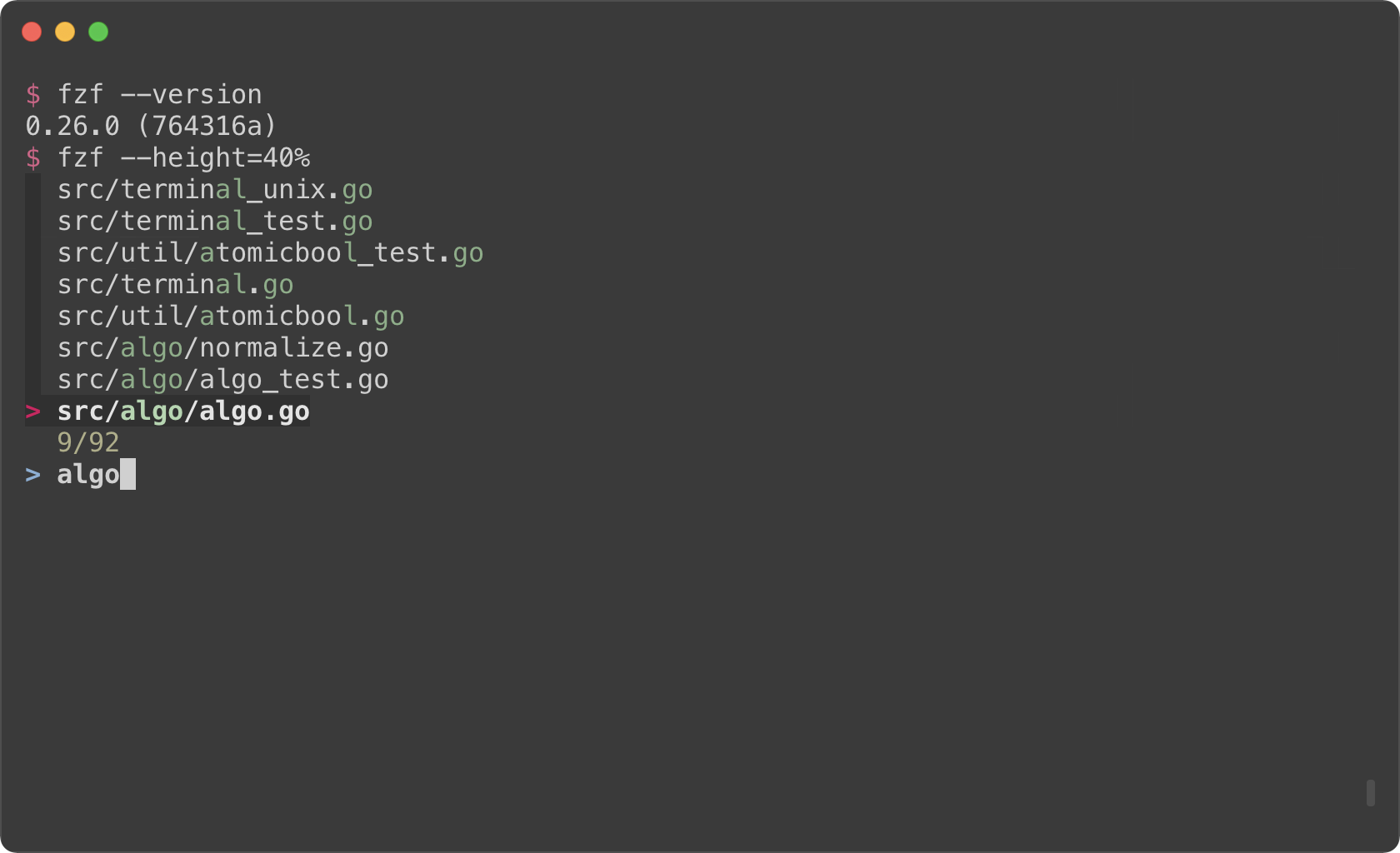
|
||
|
||
You might also want to experiment with other layout options such as
|
||
`--layout=reverse`, `--info=inline`, `--border`, `--margin`, etc.
|
||
|
||
```sh
|
||
fzf --height=40% --layout=reverse
|
||
fzf --height=40% --layout=reverse --info=inline
|
||
fzf --height=40% --layout=reverse --info=inline --border
|
||
fzf --height=40% --layout=reverse --info=inline --border --margin=1
|
||
fzf --height=40% --layout=reverse --info=inline --border --margin=1 --padding=1
|
||
```
|
||
|
||
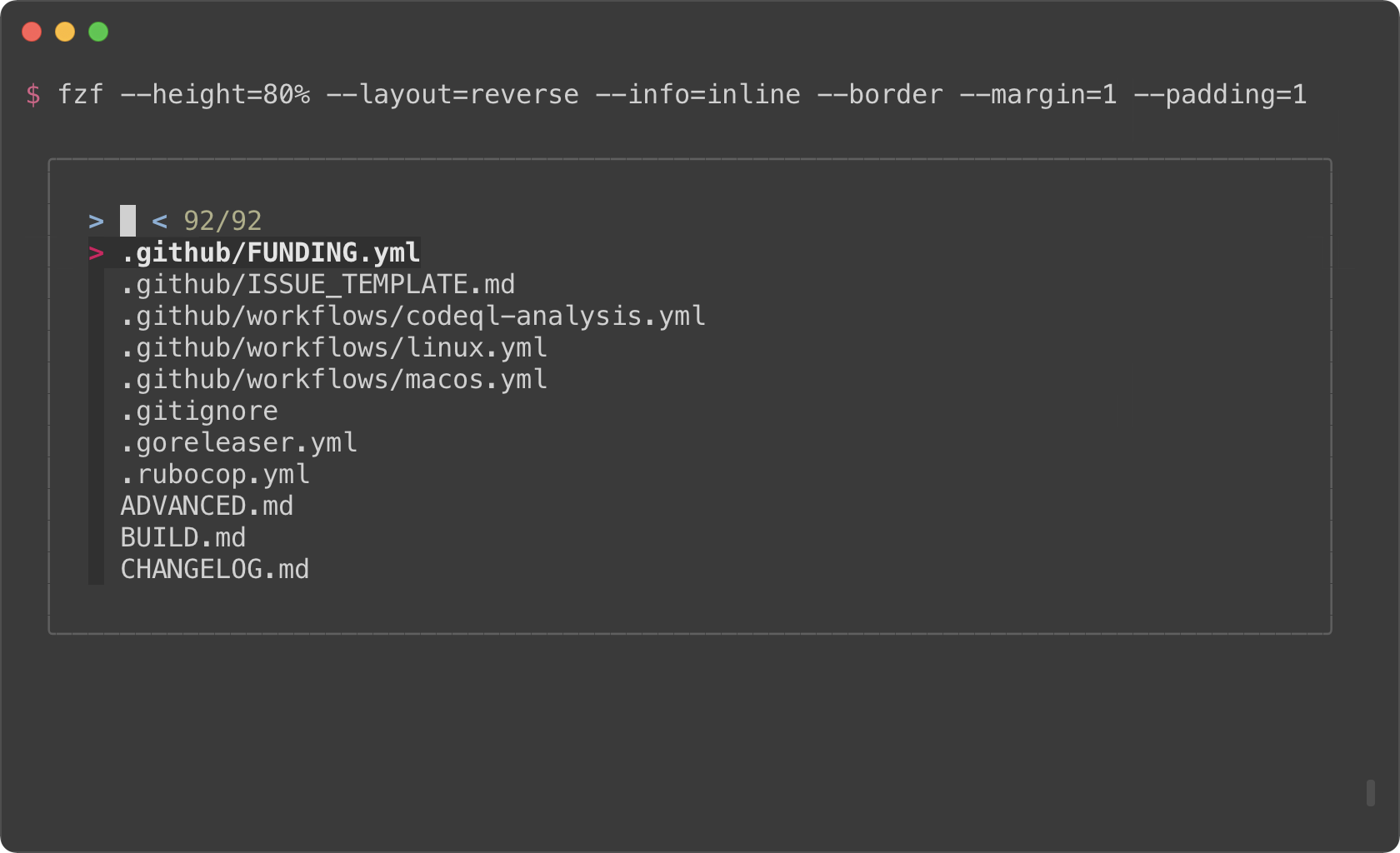
|
||
|
||
*(See `Layout` section of the man page to see the full list of options)*
|
||
|
||
But you definitely don't want to repeat `--height=40% --layout=reverse
|
||
--info=inline --border --margin=1 --padding=1` every time you use fzf. You
|
||
could write a wrapper script or shell alias, but there is an easier option.
|
||
Define `$FZF_DEFAULT_OPTS` like so:
|
||
|
||
```sh
|
||
export FZF_DEFAULT_OPTS="--height=40% --layout=reverse --info=inline --border --margin=1 --padding=1"
|
||
```
|
||
|
||
### `fzf-tmux`
|
||
|
||
Before fzf had `--height` option, we would open fzf in a tmux split pane not
|
||
to take up the whole screen. This is done using `fzf-tmux` script.
|
||
|
||
```sh
|
||
# Open fzf on a tmux split pane below the current pane.
|
||
# Takes the same set of options.
|
||
fzf-tmux --layout=reverse
|
||
```
|
||
|
||
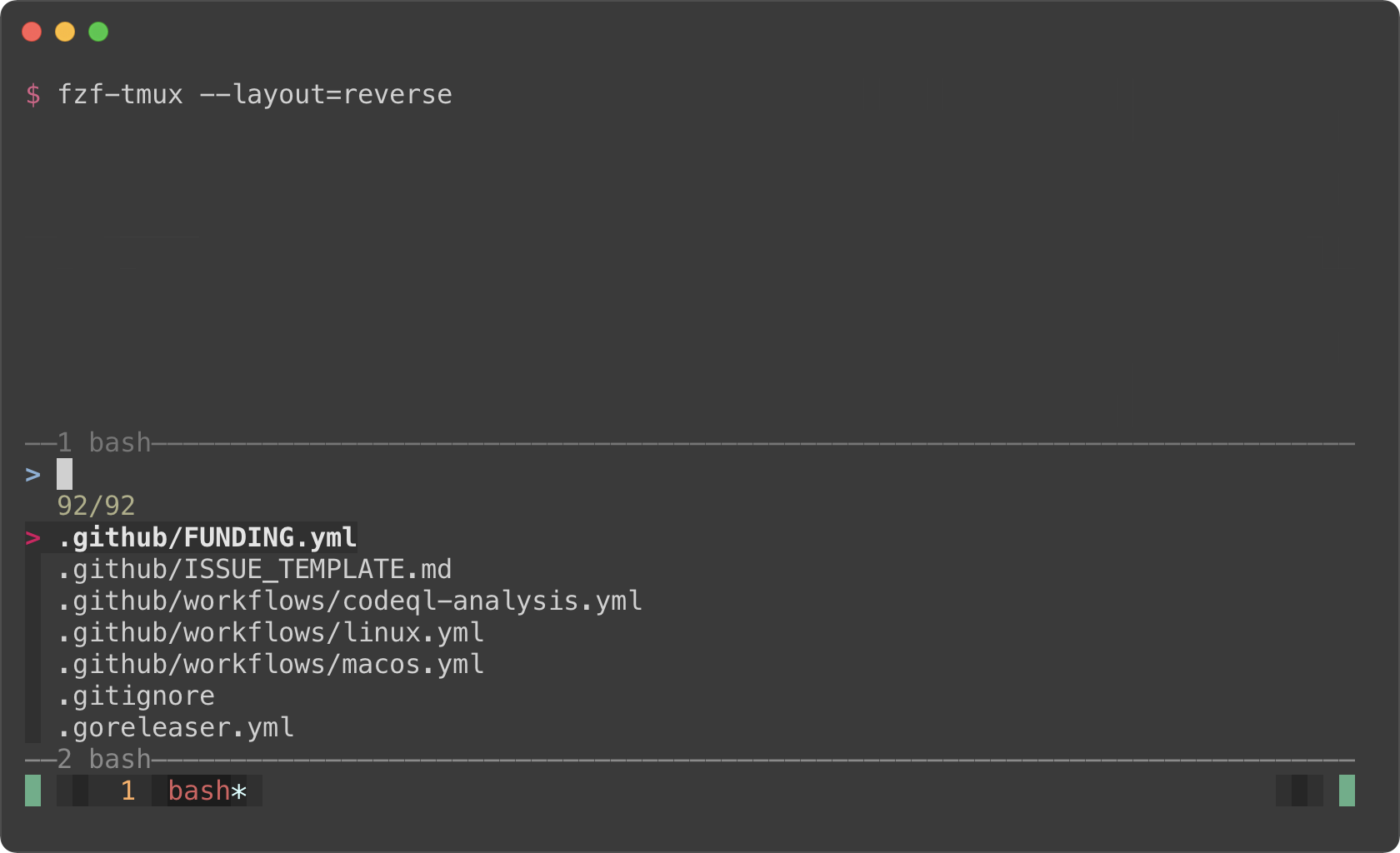
|
||
|
||
The limitation of `fzf-tmux` is that it only works when you're on tmux unlike
|
||
`--height` option. But the advantage of it is that it's more flexible.
|
||
(See `man fzf-tmux` for available options.)
|
||
|
||
```sh
|
||
# On the right (50%)
|
||
fzf-tmux -r
|
||
|
||
# On the left (30%)
|
||
fzf-tmux -l30%
|
||
|
||
# Above the cursor
|
||
fzf-tmux -u30%
|
||
```
|
||
|
||
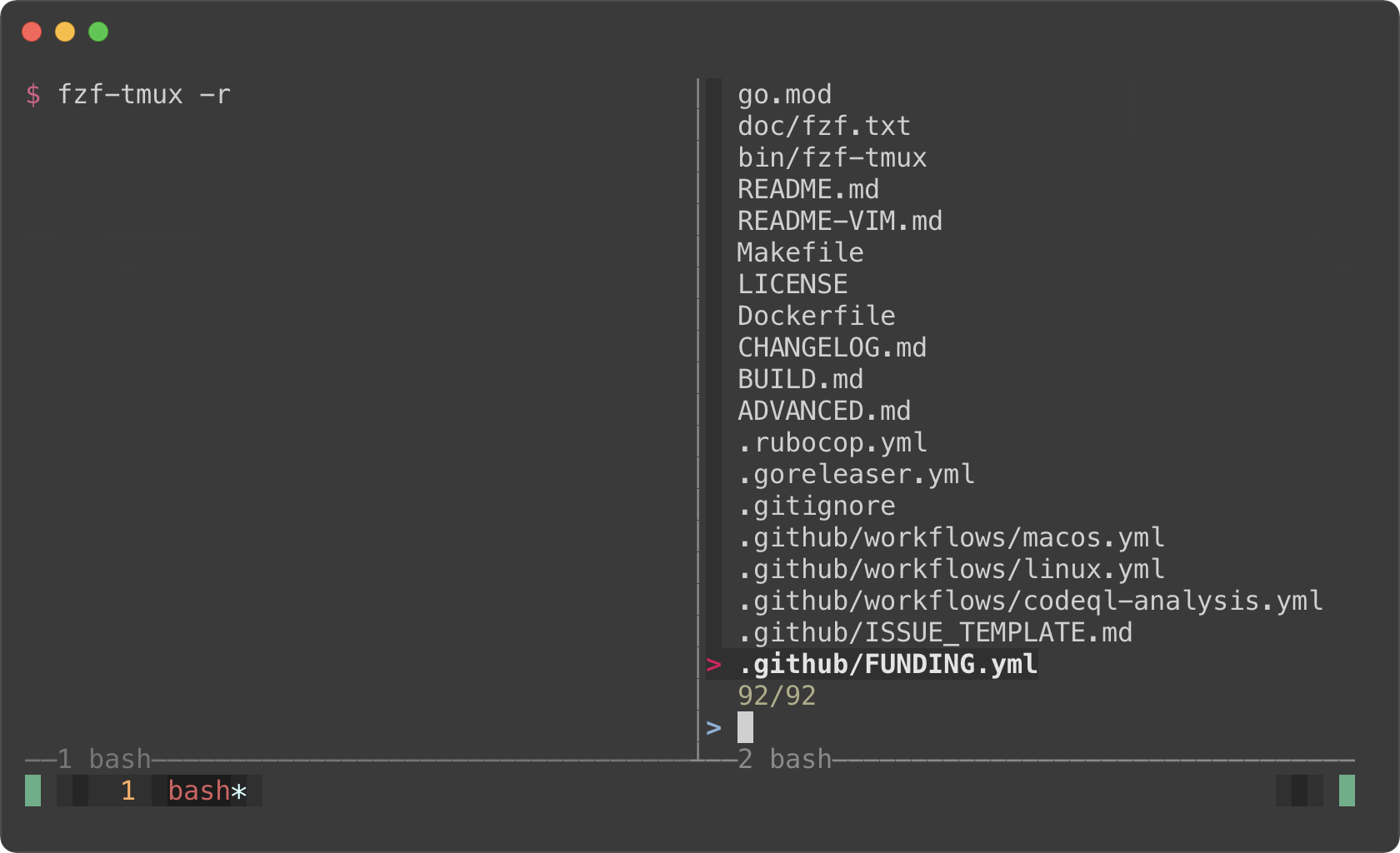
|
||
|
||
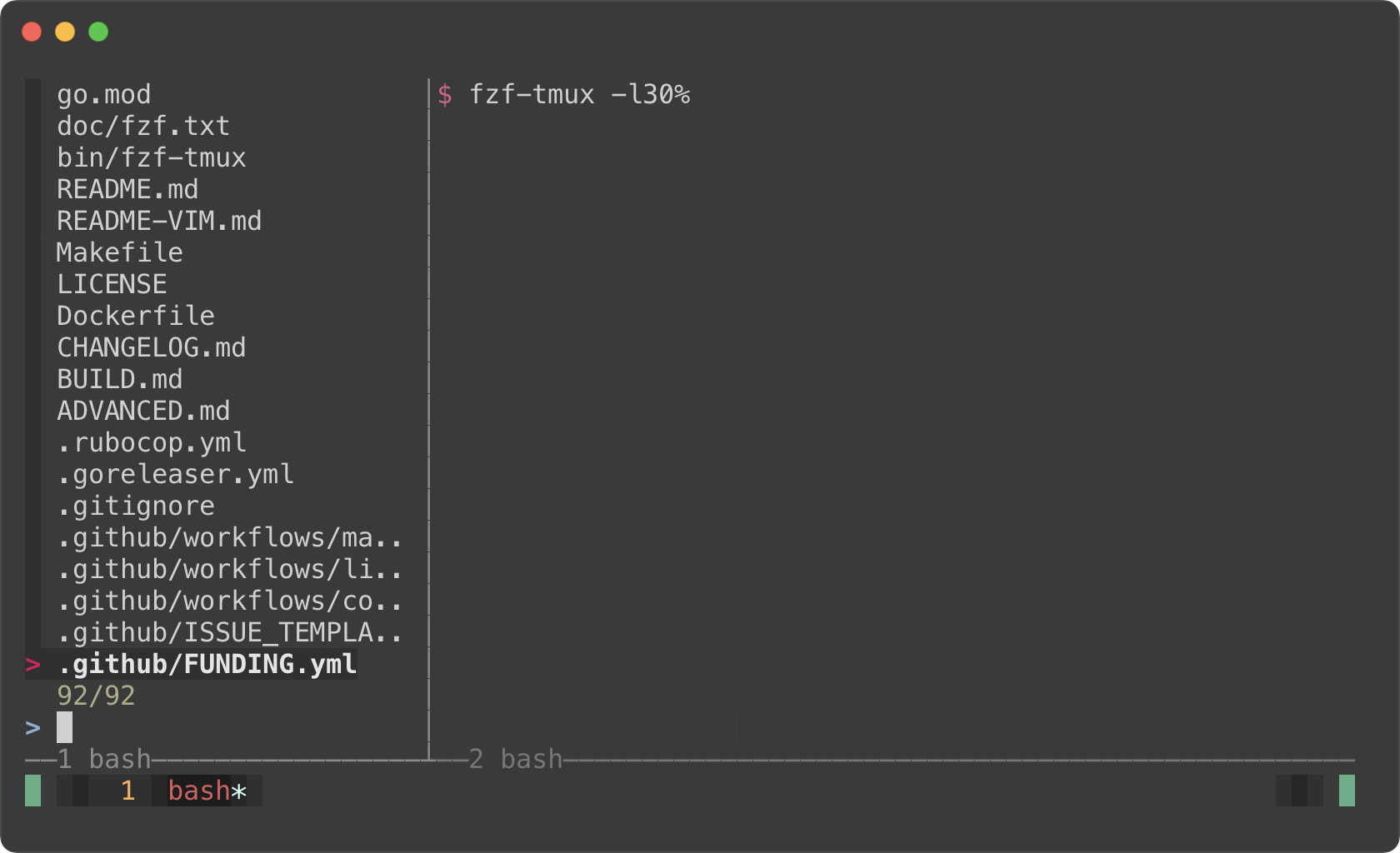
|
||
|
||
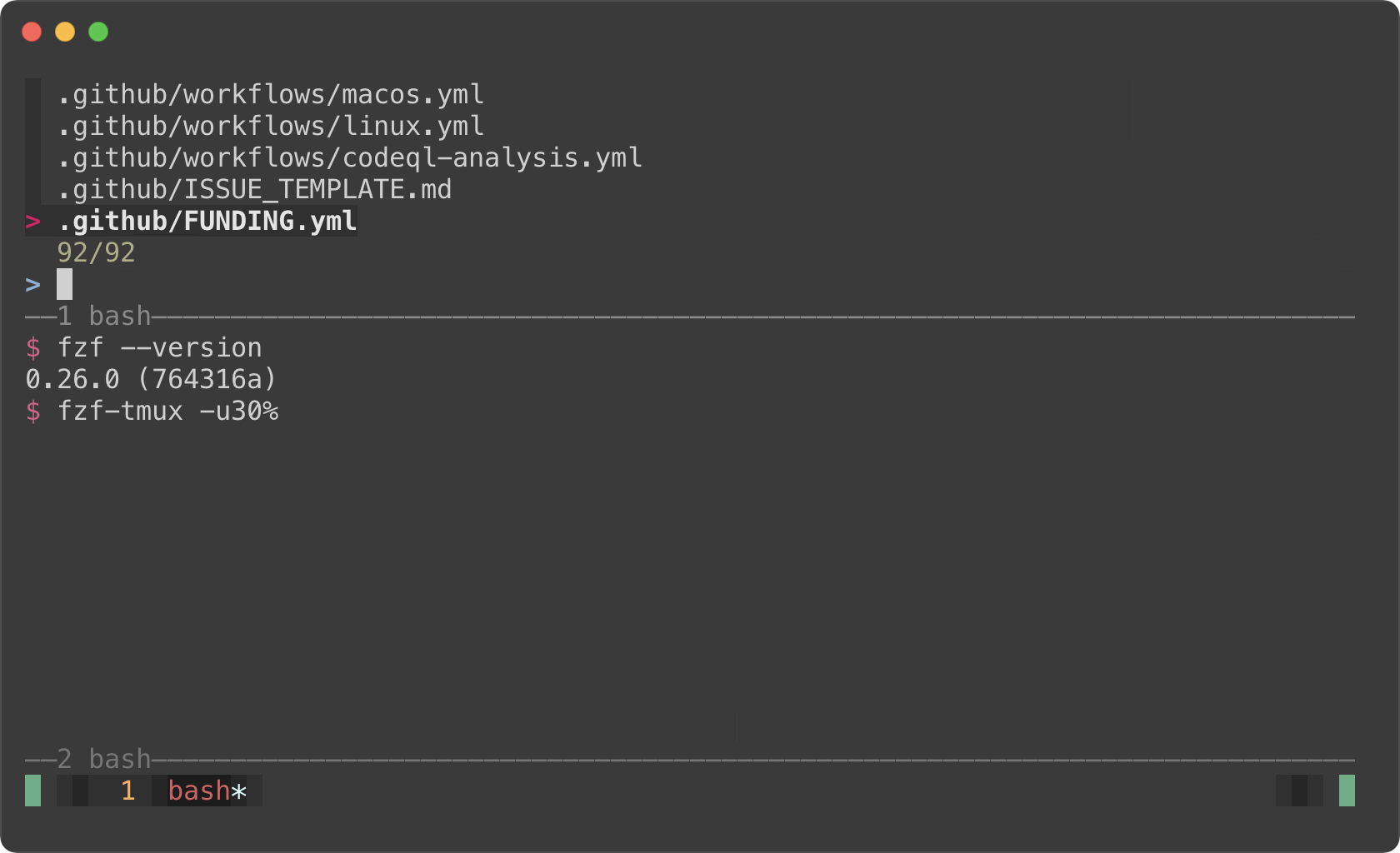
|
||
|
||
#### Popup window support
|
||
|
||
But here's the really cool part; tmux 3.2 added support for popup windows. So
|
||
you can open fzf in a popup window, which is quite useful if you frequently
|
||
use split panes.
|
||
|
||
```sh
|
||
# Open tmux in a tmux popup window (default size: 50% of the screen)
|
||
fzf-tmux -p
|
||
|
||
# 80% width, 60% height
|
||
fzf-tmux -p 80%,60%
|
||
```
|
||
|
||
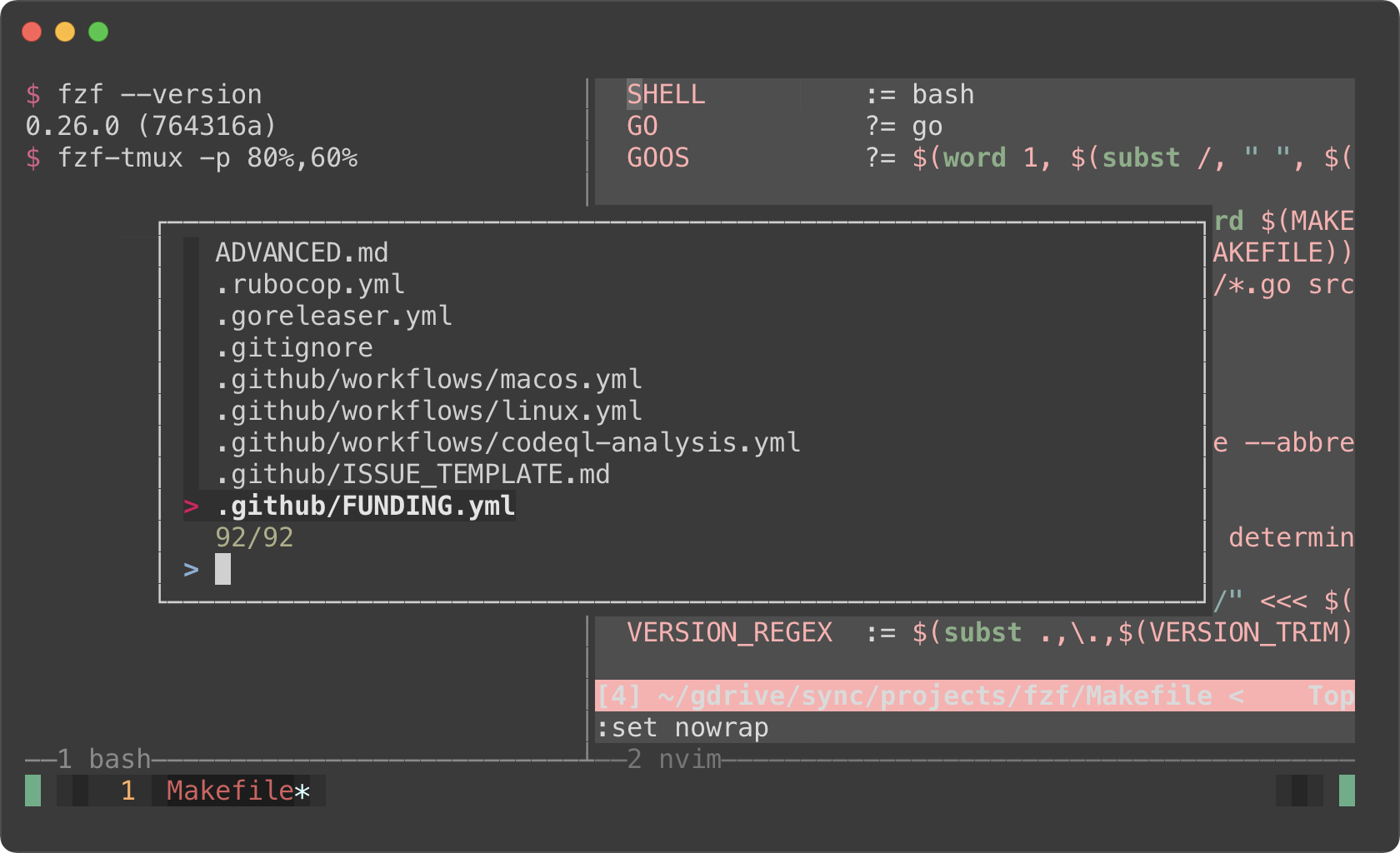
|
||
|
||
> You might also want to check out my tmux plugins which support this popup
|
||
> window layout.
|
||
>
|
||
> - https://github.com/junegunn/tmux-fzf-url
|
||
> - https://github.com/junegunn/tmux-fzf-maccy
|
||
|
||
Dynamic reloading of the list
|
||
-----------------------------
|
||
|
||
fzf can dynamically update the candidate list using an arbitrary program with
|
||
`reload` bindings (The design document for `reload` can be found
|
||
[here][reload]).
|
||
|
||
[reload]: https://github.com/junegunn/fzf/issues/1750
|
||
|
||
### Updating the list of processes by pressing CTRL-R
|
||
|
||
This example shows how you can set up a binding for dynamically updating the
|
||
list without restarting fzf.
|
||
|
||
```sh
|
||
(date; ps -ef) |
|
||
fzf --bind='ctrl-r:reload(date; ps -ef)' \
|
||
--header=$'Press CTRL-R to reload\n\n' --header-lines=2 \
|
||
--preview='echo {}' --preview-window=down,3,wrap \
|
||
--layout=reverse --height=80% | awk '{print $2}' | xargs kill -9
|
||
```
|
||
|
||
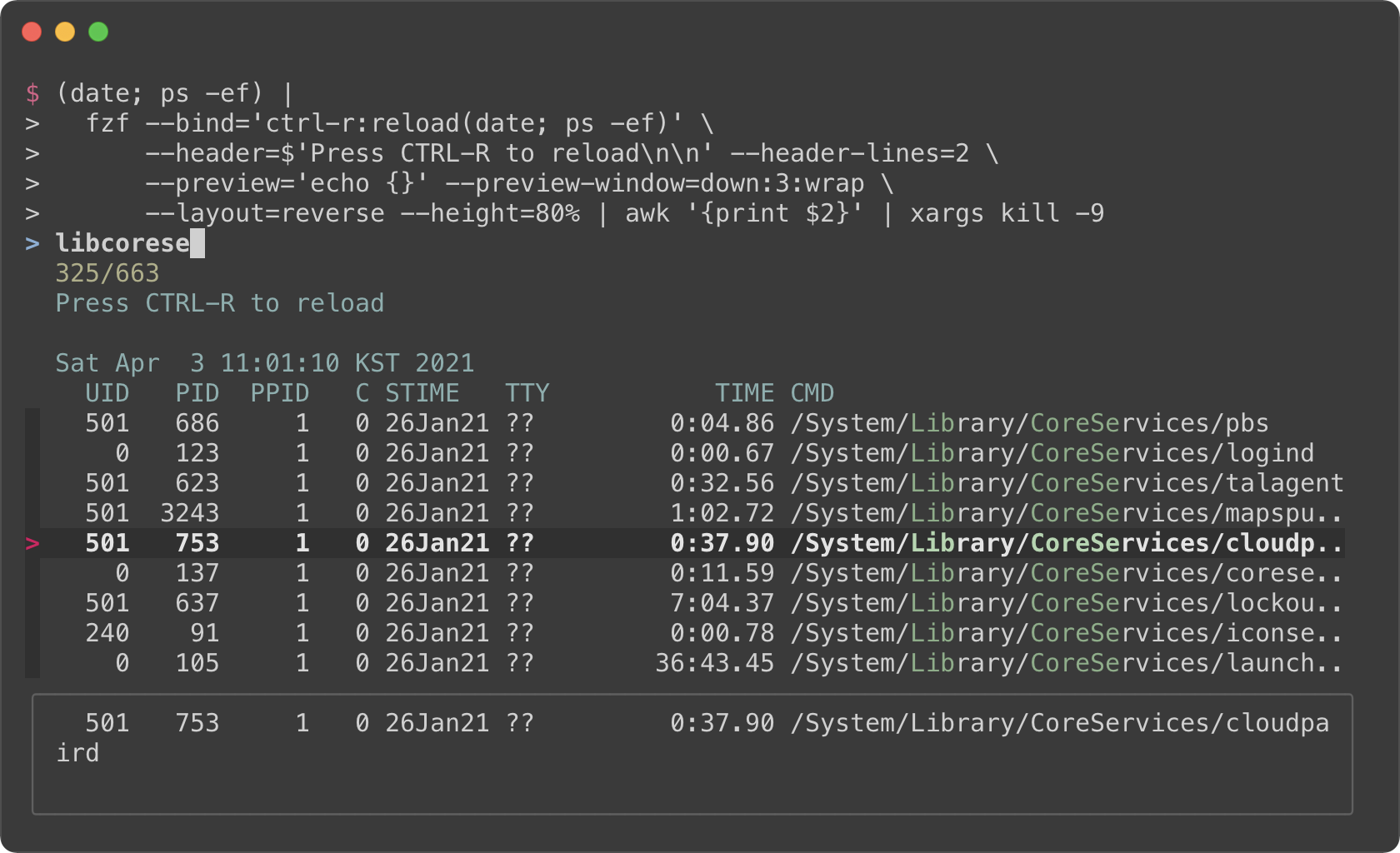
|
||
|
||
- The initial command is `(date; ps -ef)`. It prints the current date and
|
||
time, and the list of the processes.
|
||
- With `--header` option, you can show any message as the fixed header.
|
||
- To disallow selecting the first two lines (`date` and `ps` header), we use
|
||
`--header-lines=2` option.
|
||
- `--bind='ctrl-r:reload(date; ps -ef)'` binds CTRL-R to `reload` action that
|
||
runs `date; ps -ef`, so we can update the list of the processes by pressing
|
||
CTRL-R.
|
||
- We use simple `echo {}` preview option, so we can see the entire line on the
|
||
preview window below even if it's too long
|
||
|
||
### Toggling between data sources
|
||
|
||
You're not limited to just one reload binding. Set up multiple bindings so
|
||
you can switch between data sources.
|
||
|
||
```sh
|
||
find * | fzf --prompt 'All> ' \
|
||
--header 'CTRL-D: Directories / CTRL-F: Files' \
|
||
--bind 'ctrl-d:change-prompt(Directories> )+reload(find * -type d)' \
|
||
--bind 'ctrl-f:change-prompt(Files> )+reload(find * -type f)'
|
||
```
|
||
|
||
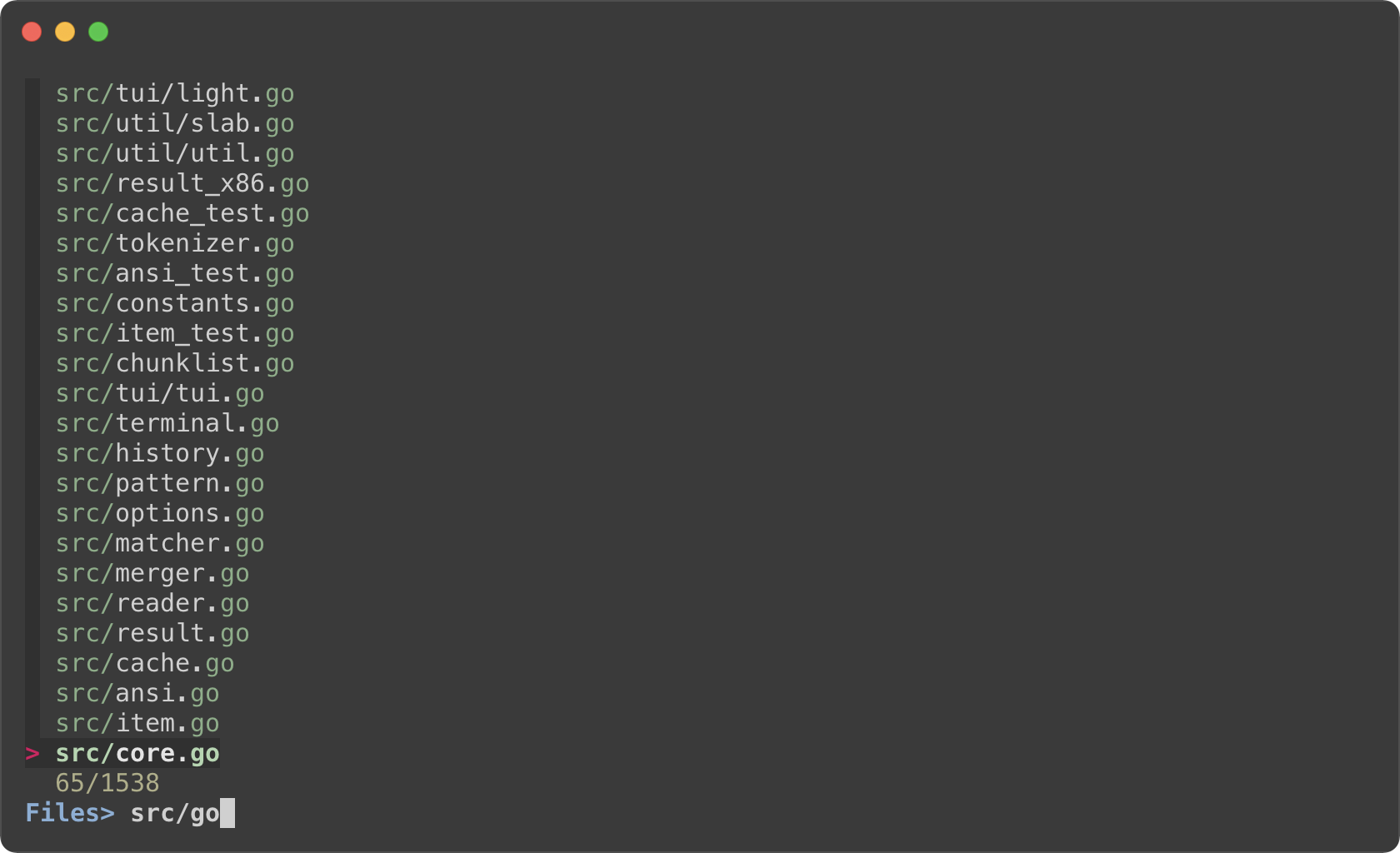
|
||
|
||
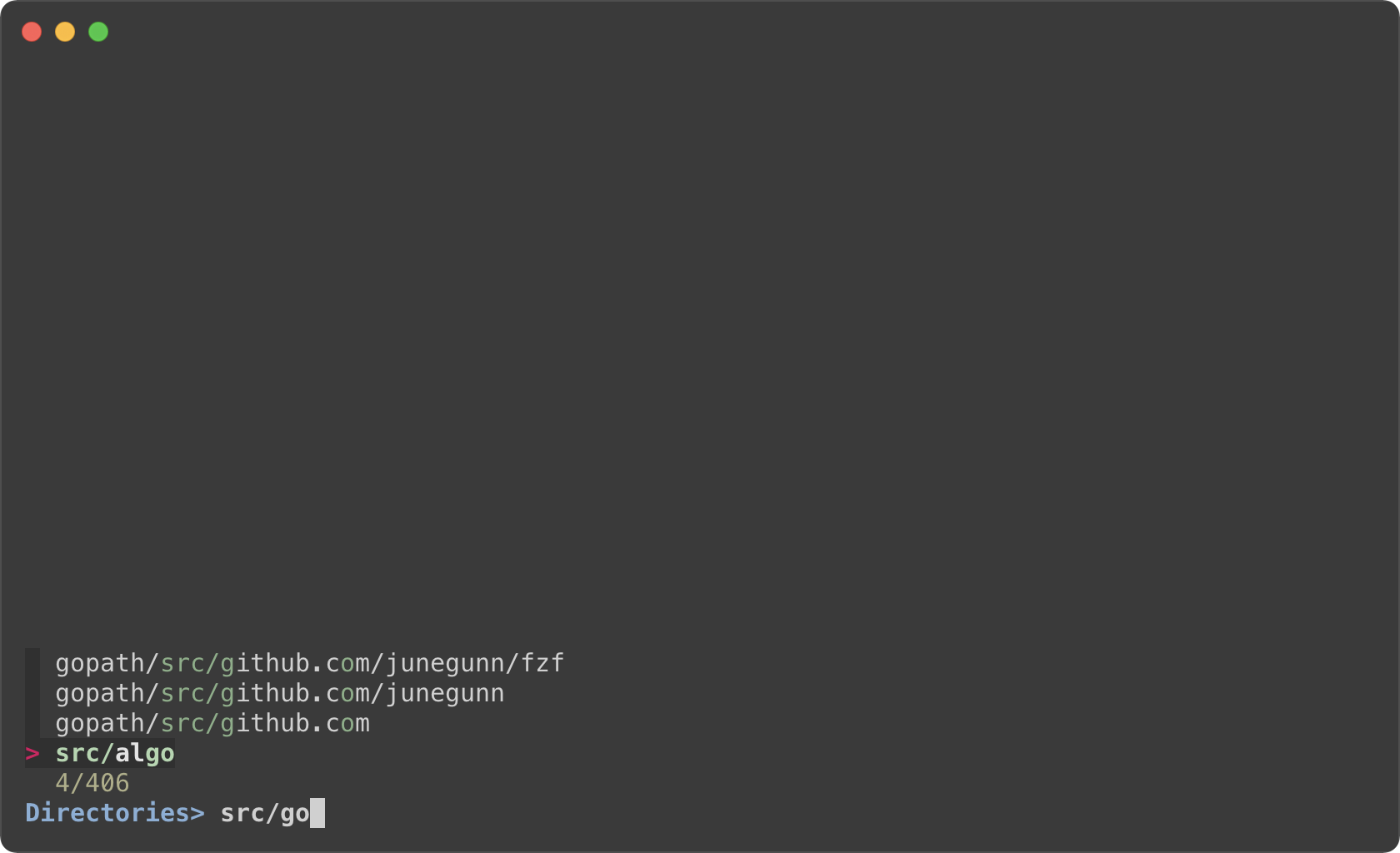
|
||
|
||
### Toggling with a single key binding
|
||
|
||
The above example uses two different key bindings to toggle between two modes,
|
||
but can we just use a single key binding?
|
||
|
||
To make a key binding behave differently each time it is pressed, we need:
|
||
|
||
1. a way to store the current state. i.e. "which mode are we in?"
|
||
2. and a way to dynamically perform different actions depending on the state.
|
||
|
||
The following example shows how to 1. store the current mode in the prompt
|
||
string, 2. and use this information (`$FZF_PROMPT`) to determine which
|
||
actions to perform using the `transform` action.
|
||
|
||
```sh
|
||
fd --type file |
|
||
fzf --prompt 'Files> ' \
|
||
--header 'CTRL-T: Switch between Files/Directories' \
|
||
--bind 'ctrl-t:transform:[[ ! $FZF_PROMPT =~ Files ]] &&
|
||
echo "change-prompt(Files> )+reload(fd --type file)" ||
|
||
echo "change-prompt(Directories> )+reload(fd --type directory)"' \
|
||
--preview '[[ $FZF_PROMPT =~ Files ]] && bat --color=always {} || tree -C {}'
|
||
```
|
||
|
||
Ripgrep integration
|
||
-------------------
|
||
|
||
### Using fzf as the secondary filter
|
||
|
||
* Requires [bat][bat]
|
||
* Requires [Ripgrep][rg]
|
||
|
||
[bat]: https://github.com/sharkdp/bat
|
||
[rg]: https://github.com/BurntSushi/ripgrep
|
||
|
||
fzf is pretty fast for filtering a list that you will rarely have to think
|
||
about its performance. But it is not the right tool for searching for text
|
||
inside many large files, and in that case you should definitely use something
|
||
like [Ripgrep][rg].
|
||
|
||
In the next example, Ripgrep is the primary filter that searches for the given
|
||
text in files, and fzf is used as the secondary fuzzy filter that adds
|
||
interactivity to the workflow. And we use [bat][bat] to show the matching line in
|
||
the preview window.
|
||
|
||
This is a bash script and it will not run as expected on other non-compliant
|
||
shells. To avoid the compatibility issue, let's save this snippet as a script
|
||
file called `rfv`.
|
||
|
||
```bash
|
||
#!/usr/bin/env bash
|
||
|
||
# 1. Search for text in files using Ripgrep
|
||
# 2. Interactively narrow down the list using fzf
|
||
# 3. Open the file in Vim
|
||
rg --color=always --line-number --no-heading --smart-case "${*:-}" |
|
||
fzf --ansi \
|
||
--color "hl:-1:underline,hl+:-1:underline:reverse" \
|
||
--delimiter : \
|
||
--preview 'bat --color=always {1} --highlight-line {2}' \
|
||
--preview-window 'up,60%,border-bottom,+{2}+3/3,~3' \
|
||
--bind 'enter:become(vim {1} +{2})'
|
||
```
|
||
|
||
And run it with an initial query string.
|
||
|
||
```sh
|
||
# Make the script executable
|
||
chmod +x rfv
|
||
|
||
# Run it with the initial query "algo"
|
||
./rfv algo
|
||
```
|
||
|
||
> Ripgrep will perform the initial search and list all the lines that contain
|
||
`algo`. Then we further narrow down the list on fzf.
|
||
|
||
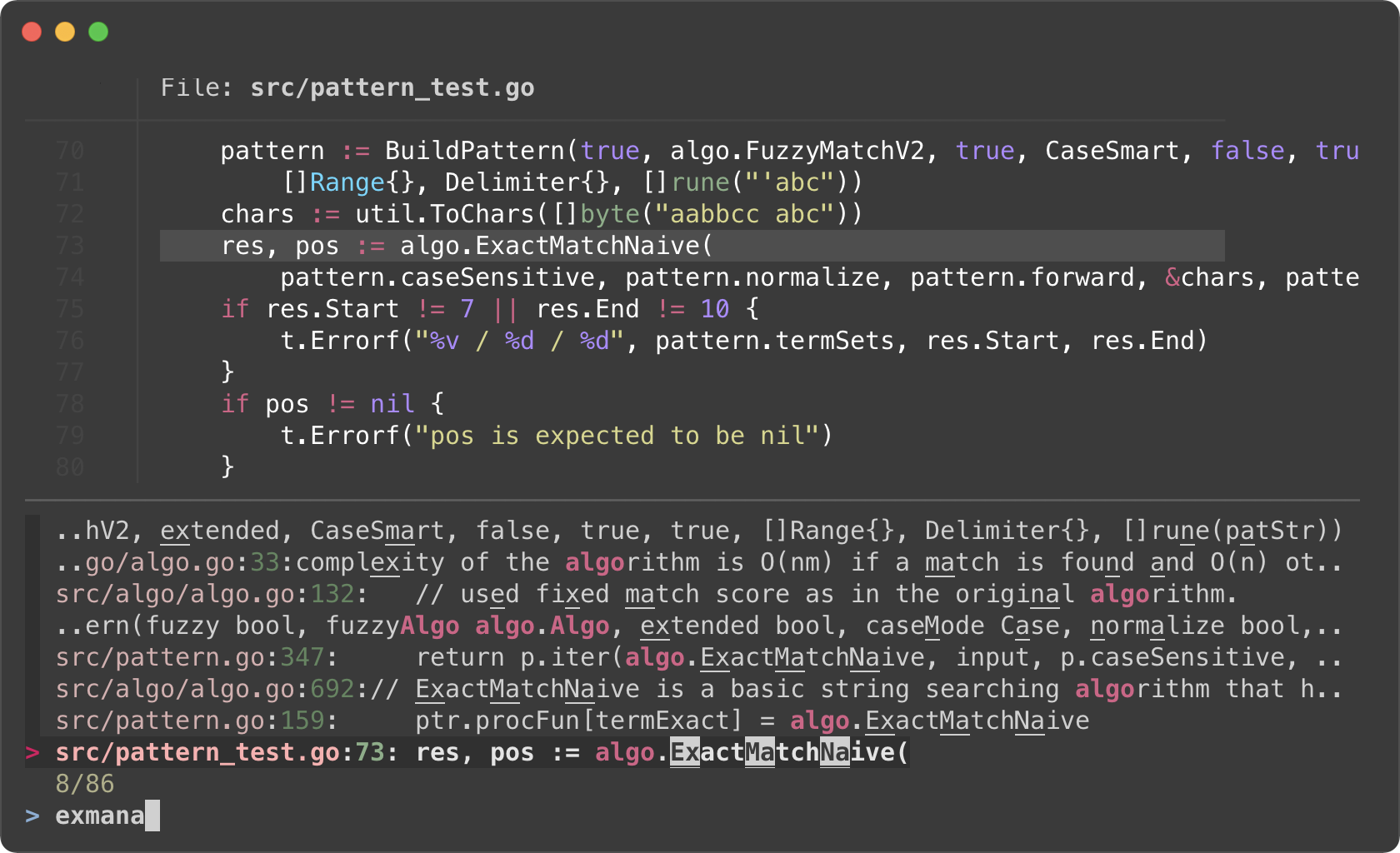
|
||
|
||
I know it's a lot to digest, let's try to break down the code.
|
||
|
||
- Ripgrep prints the matching lines in the following format
|
||
```
|
||
man/man1/fzf.1:54:.BI "--algo=" TYPE
|
||
man/man1/fzf.1:55:Fuzzy matching algorithm (default: v2)
|
||
man/man1/fzf.1:58:.BR v2 " Optimal scoring algorithm (quality)"
|
||
src/pattern_test.go:7: "github.com/junegunn/fzf/src/algo"
|
||
```
|
||
The first token delimited by `:` is the file path, and the second token is
|
||
the line number of the matching line. They respectively correspond to `{1}`
|
||
and `{2}` in the preview command.
|
||
- `--preview 'bat --color=always {1} --highlight-line {2}'`
|
||
- As we run `rg` with `--color=always` option, we should tell fzf to parse
|
||
ANSI color codes in the input by setting `--ansi`.
|
||
- We customize how fzf colors various text elements using `--color` option.
|
||
`-1` tells fzf to keep the original color from the input. See `man fzf` for
|
||
available color options.
|
||
- The value of `--preview-window` option consists of 5 components delimited
|
||
by `,`
|
||
1. `up` — Position of the preview window
|
||
1. `60%` — Size of the preview window
|
||
1. `border-bottom` — Preview window border only on the bottom side
|
||
1. `+{2}+3/3` — Scroll offset of the preview contents
|
||
1. `~3` — Fixed header
|
||
- Let's break down the latter two. We want to display the bat output in the
|
||
preview window with a certain scroll offset so that the matching line is
|
||
positioned near the center of the preview window.
|
||
- `+{2}` — The base offset is extracted from the second token
|
||
- `+3` — We add 3 lines to the base offset to compensate for the header
|
||
part of `bat` output
|
||
- ```
|
||
───────┬──────────────────────────────────────────────────────────
|
||
│ File: CHANGELOG.md
|
||
───────┼──────────────────────────────────────────────────────────
|
||
1 │ CHANGELOG
|
||
2 │ =========
|
||
3 │
|
||
4 │ 0.26.0
|
||
5 │ ------
|
||
```
|
||
- `/3` adjusts the offset so that the matching line is shown at a third
|
||
position in the window
|
||
- `~3` makes the top three lines fixed header so that they are always
|
||
visible regardless of the scroll offset
|
||
- Instead of using shell script to process the final output of fzf, we use
|
||
`become(...)` action which was added in [fzf 0.38.0][0.38.0] to turn fzf
|
||
into a new process that opens the file with `vim` (`vim {1}`) and move the
|
||
cursor to the line (`+{2}`).
|
||
|
||
[0.38.0]: https://github.com/junegunn/fzf/blob/master/CHANGELOG.md#0380
|
||
|
||
### Using fzf as interactive Ripgrep launcher
|
||
|
||
We have learned that we can bind `reload` action to a key (e.g.
|
||
`--bind=ctrl-r:execute(ps -ef)`). In the next example, we are going to **bind
|
||
`reload` action to `change` event** so that whenever the user *changes* the
|
||
query string on fzf, `reload` action is triggered.
|
||
|
||
Here is a variation of the above `rfv` script. fzf will restart Ripgrep every
|
||
time the user updates the query string on fzf. Searching and filtering is
|
||
completely done by Ripgrep, and fzf merely provides the interactive interface.
|
||
So we lose the "fuzziness", but the performance will be better on larger
|
||
projects, and it will free up memory as you narrow down the results.
|
||
|
||
```bash
|
||
#!/usr/bin/env bash
|
||
|
||
# 1. Search for text in files using Ripgrep
|
||
# 2. Interactively restart Ripgrep with reload action
|
||
# 3. Open the file in Vim
|
||
RG_PREFIX="rg --column --line-number --no-heading --color=always --smart-case "
|
||
INITIAL_QUERY="${*:-}"
|
||
: | fzf --ansi --disabled --query "$INITIAL_QUERY" \
|
||
--bind "start:reload:$RG_PREFIX {q}" \
|
||
--bind "change:reload:sleep 0.1; $RG_PREFIX {q} || true" \
|
||
--delimiter : \
|
||
--preview 'bat --color=always {1} --highlight-line {2}' \
|
||
--preview-window 'up,60%,border-bottom,+{2}+3/3,~3' \
|
||
--bind 'enter:become(vim {1} +{2})'
|
||
```
|
||
|
||
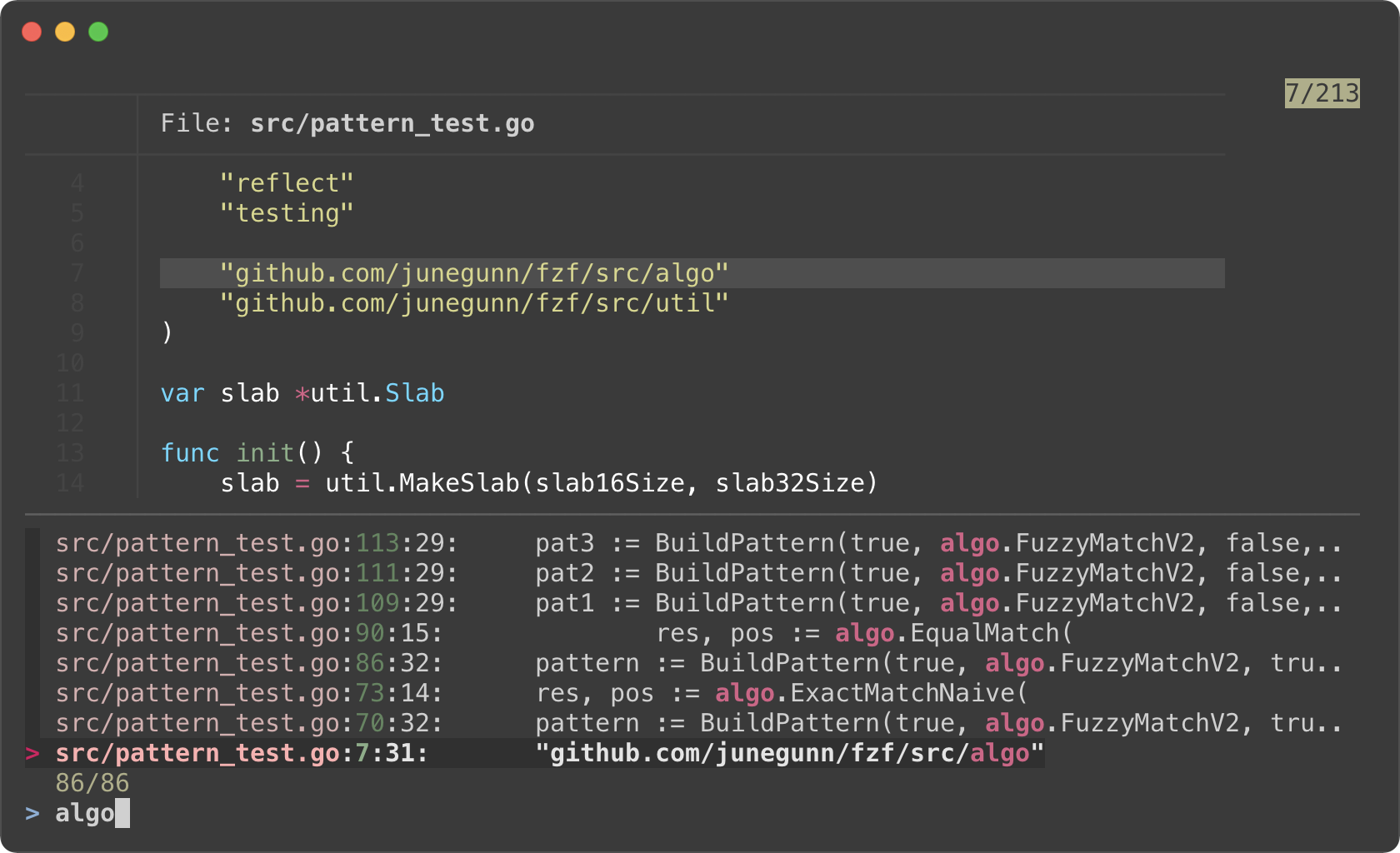
|
||
|
||
- Instead of starting fzf in the usual `rg ... | fzf` form, we start fzf with
|
||
an empty input (`: | fzf`), then we make it start the initial Ripgrep
|
||
process immediately via `start:reload` binding. This way, fzf owns the
|
||
initial Ripgrep process so it can kill it on the next `reload`. Otherwise,
|
||
the process will keep running in the background.
|
||
- Filtering is no longer a responsibility of fzf; hence `--disabled`
|
||
- `{q}` in the reload command evaluates to the query string on fzf prompt.
|
||
- `sleep 0.1` in the reload command is for "debouncing". This small delay will
|
||
reduce the number of intermediate Ripgrep processes while we're typing in
|
||
a query.
|
||
|
||
### Switching to fzf-only search mode
|
||
|
||
In the previous example, we lost fuzzy matching capability as we completely
|
||
delegated search functionality to Ripgrep. But we can dynamically switch to
|
||
fzf-only search mode by *"unbinding"* `reload` action from `change` event.
|
||
|
||
```sh
|
||
#!/usr/bin/env bash
|
||
|
||
# Two-phase filtering with Ripgrep and fzf
|
||
#
|
||
# 1. Search for text in files using Ripgrep
|
||
# 2. Interactively restart Ripgrep with reload action
|
||
# * Press alt-enter to switch to fzf-only filtering
|
||
# 3. Open the file in Vim
|
||
RG_PREFIX="rg --column --line-number --no-heading --color=always --smart-case "
|
||
INITIAL_QUERY="${*:-}"
|
||
: | fzf --ansi --disabled --query "$INITIAL_QUERY" \
|
||
--bind "start:reload:$RG_PREFIX {q}" \
|
||
--bind "change:reload:sleep 0.1; $RG_PREFIX {q} || true" \
|
||
--bind "alt-enter:unbind(change,alt-enter)+change-prompt(2. fzf> )+enable-search+clear-query" \
|
||
--color "hl:-1:underline,hl+:-1:underline:reverse" \
|
||
--prompt '1. ripgrep> ' \
|
||
--delimiter : \
|
||
--preview 'bat --color=always {1} --highlight-line {2}' \
|
||
--preview-window 'up,60%,border-bottom,+{2}+3/3,~3' \
|
||
--bind 'enter:become(vim {1} +{2})'
|
||
```
|
||
|
||
* Phase 1. Filtering with Ripgrep
|
||
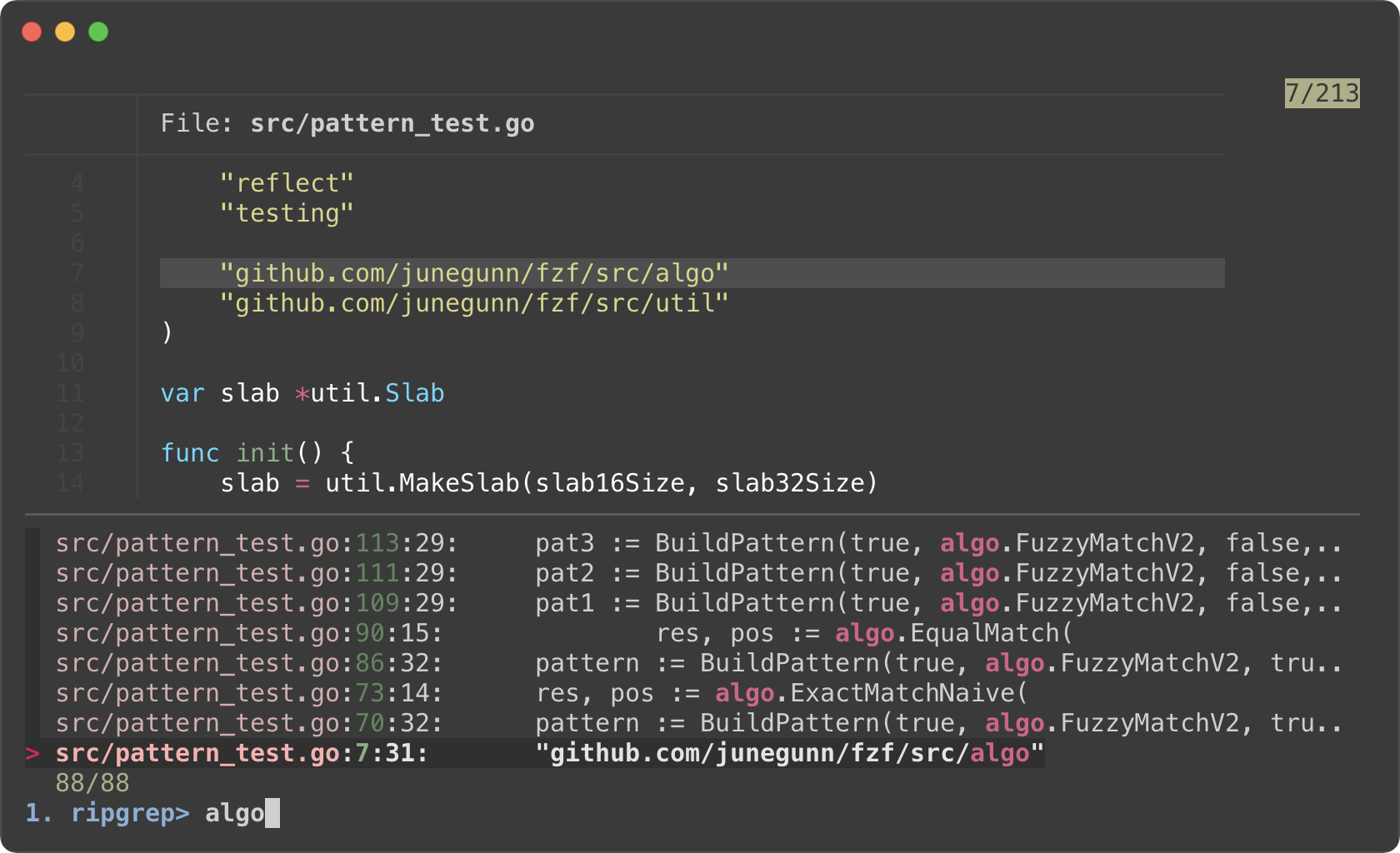
|
||
* Phase 2. Filtering with fzf
|
||
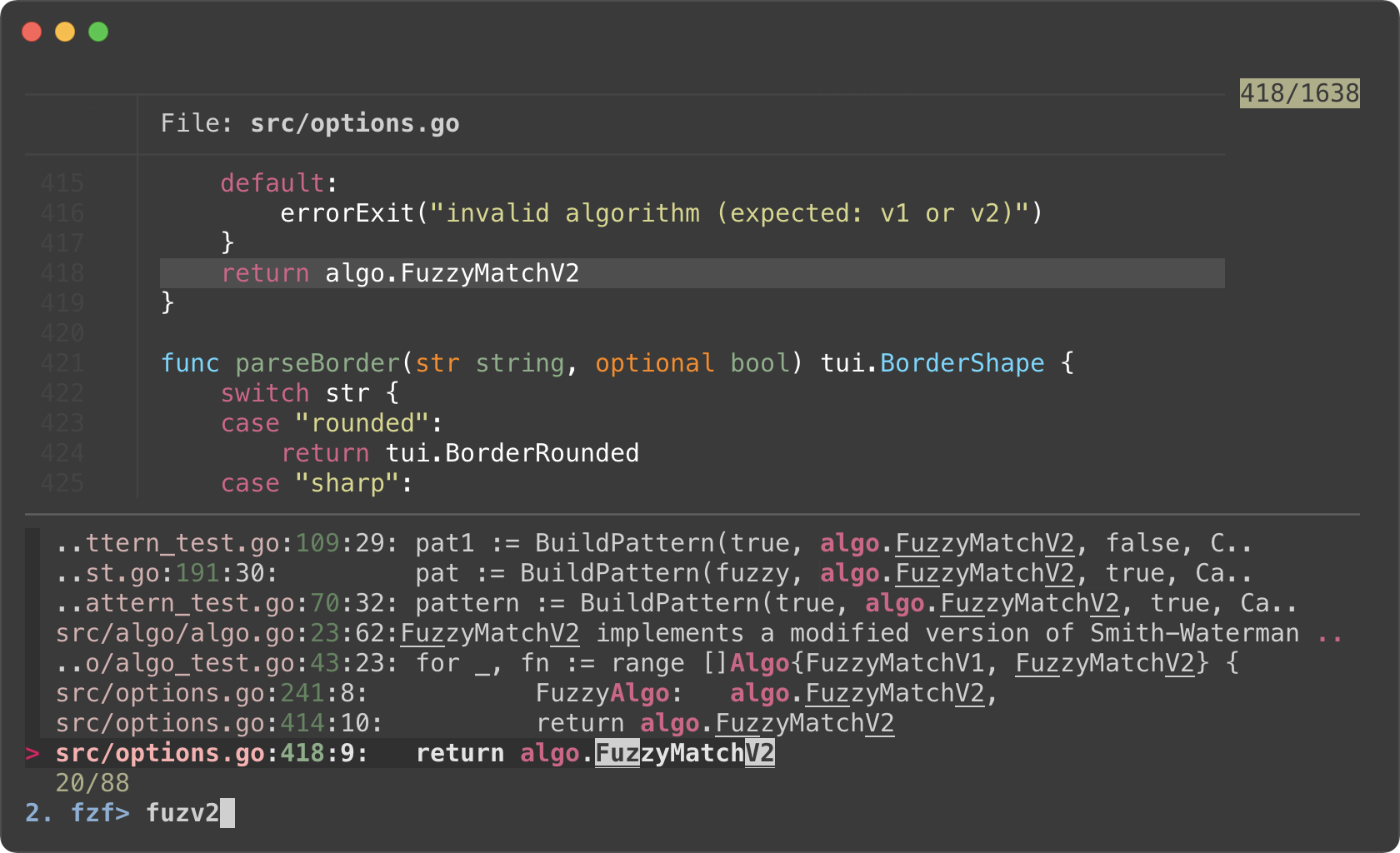
|
||
|
||
- We added `--prompt` option to show that fzf is initially running in "Ripgrep
|
||
launcher mode".
|
||
- We added `alt-enter` binding that
|
||
1. unbinds `change` event, so Ripgrep is no longer restarted on key press
|
||
2. changes the prompt to `2. fzf>`
|
||
3. enables search functionality of fzf
|
||
4. clears the current query string that was used to start Ripgrep process
|
||
5. and unbinds `alt-enter` itself as this is a one-off event
|
||
- We reverted `--color` option for customizing how the matching chunks are
|
||
displayed in the second phase
|
||
|
||
### Switching between Ripgrep mode and fzf mode
|
||
|
||
[fzf 0.30.0][0.30.0] added `rebind` action so we can "rebind" the bindings
|
||
that were previously "unbound" via `unbind`.
|
||
|
||
This is an improved version of the previous example that allows us to switch
|
||
between Ripgrep launcher mode and fzf-only filtering mode via CTRL-R and
|
||
CTRL-F.
|
||
|
||
```sh
|
||
#!/usr/bin/env bash
|
||
|
||
# Switch between Ripgrep launcher mode (CTRL-R) and fzf filtering mode (CTRL-F)
|
||
rm -f /tmp/rg-fzf-{r,f}
|
||
RG_PREFIX="rg --column --line-number --no-heading --color=always --smart-case "
|
||
INITIAL_QUERY="${*:-}"
|
||
: | fzf --ansi --disabled --query "$INITIAL_QUERY" \
|
||
--bind "start:reload($RG_PREFIX {q})+unbind(ctrl-r)" \
|
||
--bind "change:reload:sleep 0.1; $RG_PREFIX {q} || true" \
|
||
--bind "ctrl-f:unbind(change,ctrl-f)+change-prompt(2. fzf> )+enable-search+rebind(ctrl-r)+transform-query(echo {q} > /tmp/rg-fzf-r; cat /tmp/rg-fzf-f)" \
|
||
--bind "ctrl-r:unbind(ctrl-r)+change-prompt(1. ripgrep> )+disable-search+reload($RG_PREFIX {q} || true)+rebind(change,ctrl-f)+transform-query(echo {q} > /tmp/rg-fzf-f; cat /tmp/rg-fzf-r)" \
|
||
--color "hl:-1:underline,hl+:-1:underline:reverse" \
|
||
--prompt '1. ripgrep> ' \
|
||
--delimiter : \
|
||
--header '╱ CTRL-R (ripgrep mode) ╱ CTRL-F (fzf mode) ╱' \
|
||
--preview 'bat --color=always {1} --highlight-line {2}' \
|
||
--preview-window 'up,60%,border-bottom,+{2}+3/3,~3' \
|
||
--bind 'enter:become(vim {1} +{2})'
|
||
```
|
||
|
||
- To restore the query string when switching between modes, we store the
|
||
current query in `/tmp/rg-fzf-{r,f}` files and restore the query using
|
||
`transform-query` action which was added in [fzf 0.36.0][0.36.0].
|
||
- Also note that we unbind `ctrl-r` binding on `start` event which is
|
||
triggered once when fzf starts.
|
||
|
||
[0.30.0]: https://github.com/junegunn/fzf/blob/master/CHANGELOG.md#0300
|
||
[0.36.0]: https://github.com/junegunn/fzf/blob/master/CHANGELOG.md#0360
|
||
|
||
### Switching between Ripgrep mode and fzf mode using a single key binding
|
||
|
||
In contrast to the previous version, we use just one hotkey to toggle between
|
||
ripgrep and fzf mode. This is achieved by using the `$FZF_PROMPT` as a state
|
||
within the `transform` action, a feature introduced in [fzf 0.45.0][0.45.0]. A
|
||
more detailed explanation of this feature can be found in a previous section -
|
||
[Toggling with a single keybinding](#toggling-with-a-single-key-binding).
|
||
|
||
[0.45.0]: https://github.com/junegunn/fzf/blob/master/CHANGELOG.md#0450
|
||
|
||
When using the `transform` action, the placeholder (`\{q}`) should be escaped to
|
||
prevent immediate evaluation.
|
||
|
||
```sh
|
||
#!/usr/bin/env bash
|
||
|
||
# Switch between Ripgrep mode and fzf filtering mode (CTRL-T)
|
||
rm -f /tmp/rg-fzf-{r,f}
|
||
RG_PREFIX="rg --column --line-number --no-heading --color=always --smart-case "
|
||
INITIAL_QUERY="${*:-}"
|
||
: | fzf --ansi --disabled --query "$INITIAL_QUERY" \
|
||
--bind "start:reload:$RG_PREFIX {q}" \
|
||
--bind "change:reload:sleep 0.1; $RG_PREFIX {q} || true" \
|
||
--bind 'ctrl-t:transform:[[ ! $FZF_PROMPT =~ ripgrep ]] &&
|
||
echo "rebind(change)+change-prompt(1. ripgrep> )+disable-search+transform-query:echo \{q} > /tmp/rg-fzf-f; cat /tmp/rg-fzf-r" ||
|
||
echo "unbind(change)+change-prompt(2. fzf> )+enable-search+transform-query:echo \{q} > /tmp/rg-fzf-r; cat /tmp/rg-fzf-f"' \
|
||
--color "hl:-1:underline,hl+:-1:underline:reverse" \
|
||
--prompt '1. ripgrep> ' \
|
||
--delimiter : \
|
||
--header 'CTRL-T: Switch between ripgrep/fzf' \
|
||
--preview 'bat --color=always {1} --highlight-line {2}' \
|
||
--preview-window 'up,60%,border-bottom,+{2}+3/3,~3' \
|
||
--bind 'enter:become(vim {1} +{2})'
|
||
```
|
||
|
||
Log tailing
|
||
-----------
|
||
|
||
fzf can run long-running preview commands and render partial results before
|
||
completion. And when you specify `follow` flag in `--preview-window` option,
|
||
fzf will "`tail -f`" the result, automatically scrolling to the bottom.
|
||
|
||
```bash
|
||
# With "follow", preview window will automatically scroll to the bottom.
|
||
# "\033[2J" is an ANSI escape sequence for clearing the screen.
|
||
# When fzf reads this code it clears the previous preview contents.
|
||
fzf --preview-window follow --preview 'for i in $(seq 100000); do
|
||
echo "$i"
|
||
sleep 0.01
|
||
(( i % 300 == 0 )) && printf "\033[2J"
|
||
done'
|
||
```
|
||
|
||
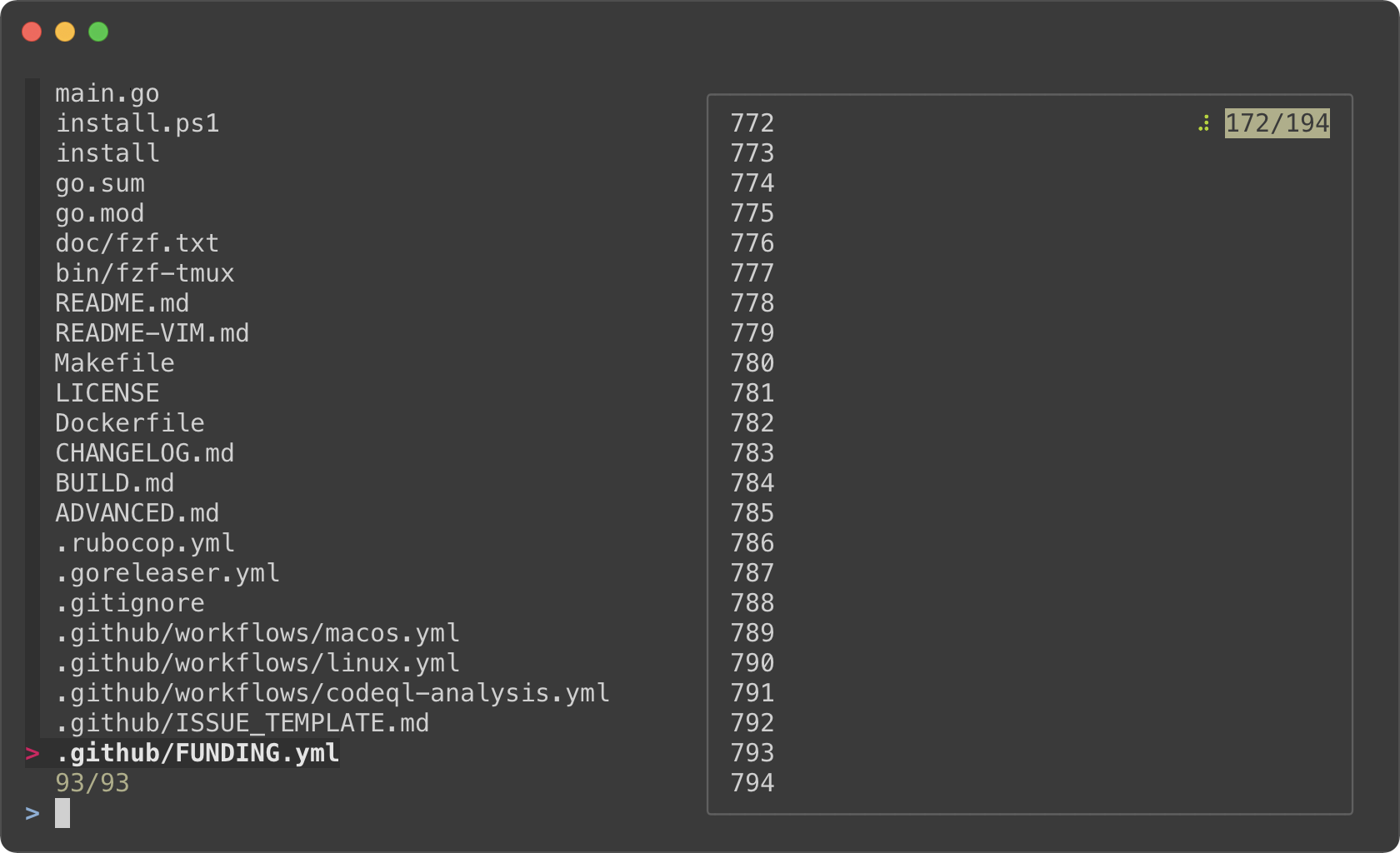
|
||
|
||
Admittedly, that was a silly example. Here's a practical one for browsing
|
||
Kubernetes pods.
|
||
|
||
```bash
|
||
pods() {
|
||
: | command='kubectl get pods --all-namespaces' fzf \
|
||
--info=inline --layout=reverse --header-lines=1 \
|
||
--prompt "$(kubectl config current-context | sed 's/-context$//')> " \
|
||
--header $'╱ Enter (kubectl exec) ╱ CTRL-O (open log in editor) ╱ CTRL-R (reload) ╱\n\n' \
|
||
--bind 'start:reload:$command' \
|
||
--bind 'ctrl-r:reload:$command' \
|
||
--bind 'ctrl-/:change-preview-window(80%,border-bottom|hidden|)' \
|
||
--bind 'enter:execute:kubectl exec -it --namespace {1} {2} -- bash > /dev/tty' \
|
||
--bind 'ctrl-o:execute:${EDITOR:-vim} <(kubectl logs --all-containers --namespace {1} {2}) > /dev/tty' \
|
||
--preview-window up:follow \
|
||
--preview 'kubectl logs --follow --all-containers --tail=10000 --namespace {1} {2}' "$@"
|
||
}
|
||
```
|
||
|
||
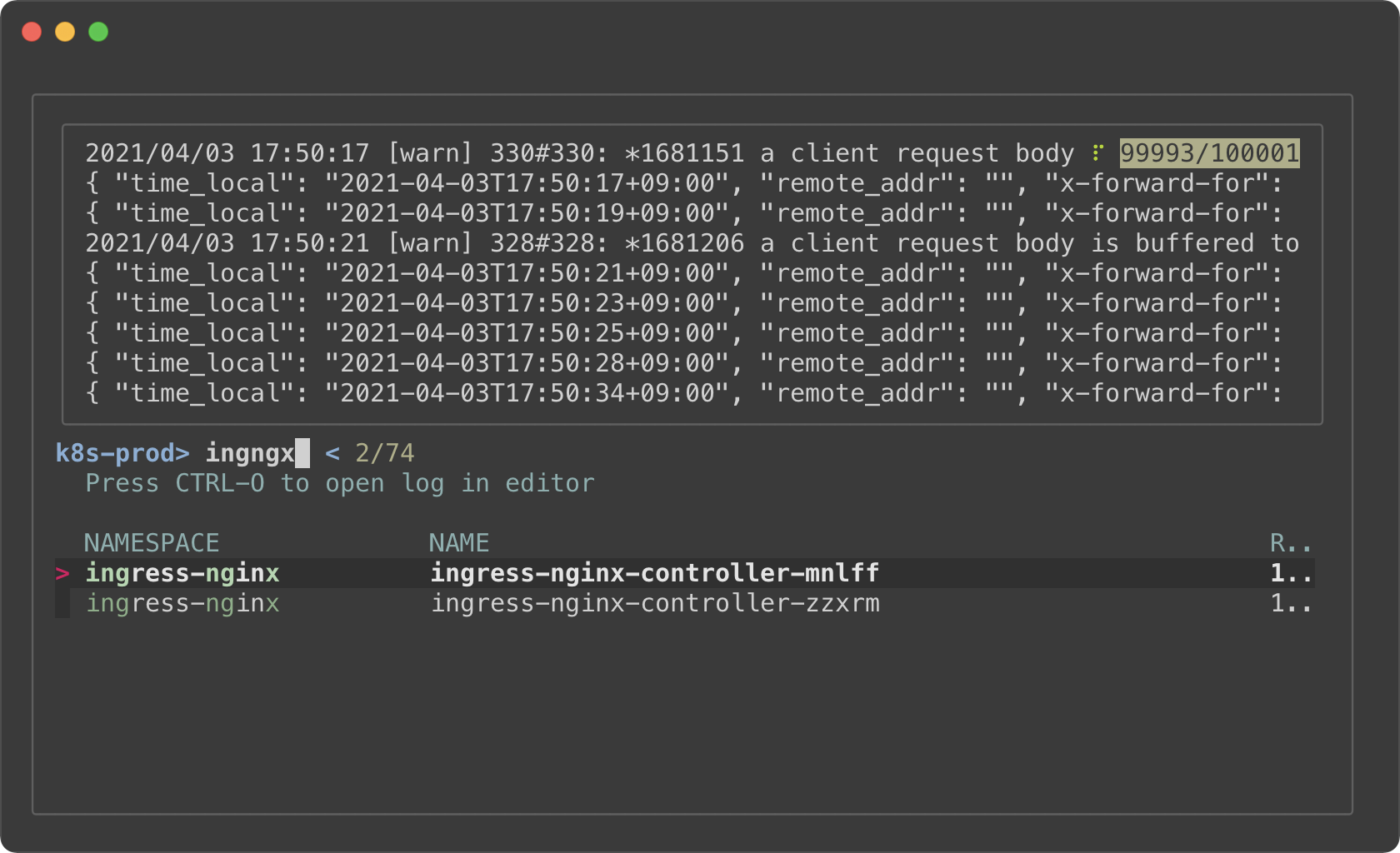
|
||
|
||
- The preview window will *"log tail"* the pod
|
||
- Holding on to a large amount of log will consume a lot of memory. So we
|
||
limited the initial log amount with `--tail=10000`.
|
||
- `execute` bindings allow you to run any command without leaving fzf
|
||
- Press enter key on a pod to `kubectl exec` into it
|
||
- Press CTRL-O to open the log in your editor
|
||
- Press CTRL-R to reload the pod list
|
||
- Press CTRL-/ repeatedly to rotate through a different sets of preview
|
||
window options
|
||
1. `80%,border-bottom`
|
||
1. `hidden`
|
||
1. Empty string after `|` translates to the default options from `--preview-window`
|
||
|
||
Key bindings for git objects
|
||
----------------------------
|
||
|
||
Oftentimes, you want to put the identifiers of various Git object to the
|
||
command-line. For example, it is common to write commands like these:
|
||
|
||
```sh
|
||
git checkout [SOME_COMMIT_HASH or BRANCH or TAG]
|
||
git diff [SOME_COMMIT_HASH or BRANCH or TAG] [SOME_COMMIT_HASH or BRANCH or TAG]
|
||
```
|
||
|
||
[fzf-git.sh](https://github.com/junegunn/fzf-git.sh) project defines a set of
|
||
fzf-based key bindings for Git objects. I strongly recommend that you check
|
||
them out because they are seriously useful.
|
||
|
||
### Files listed in `git status`
|
||
|
||
<kbd>CTRL-G</kbd><kbd>CTRL-F</kbd>
|
||
|
||
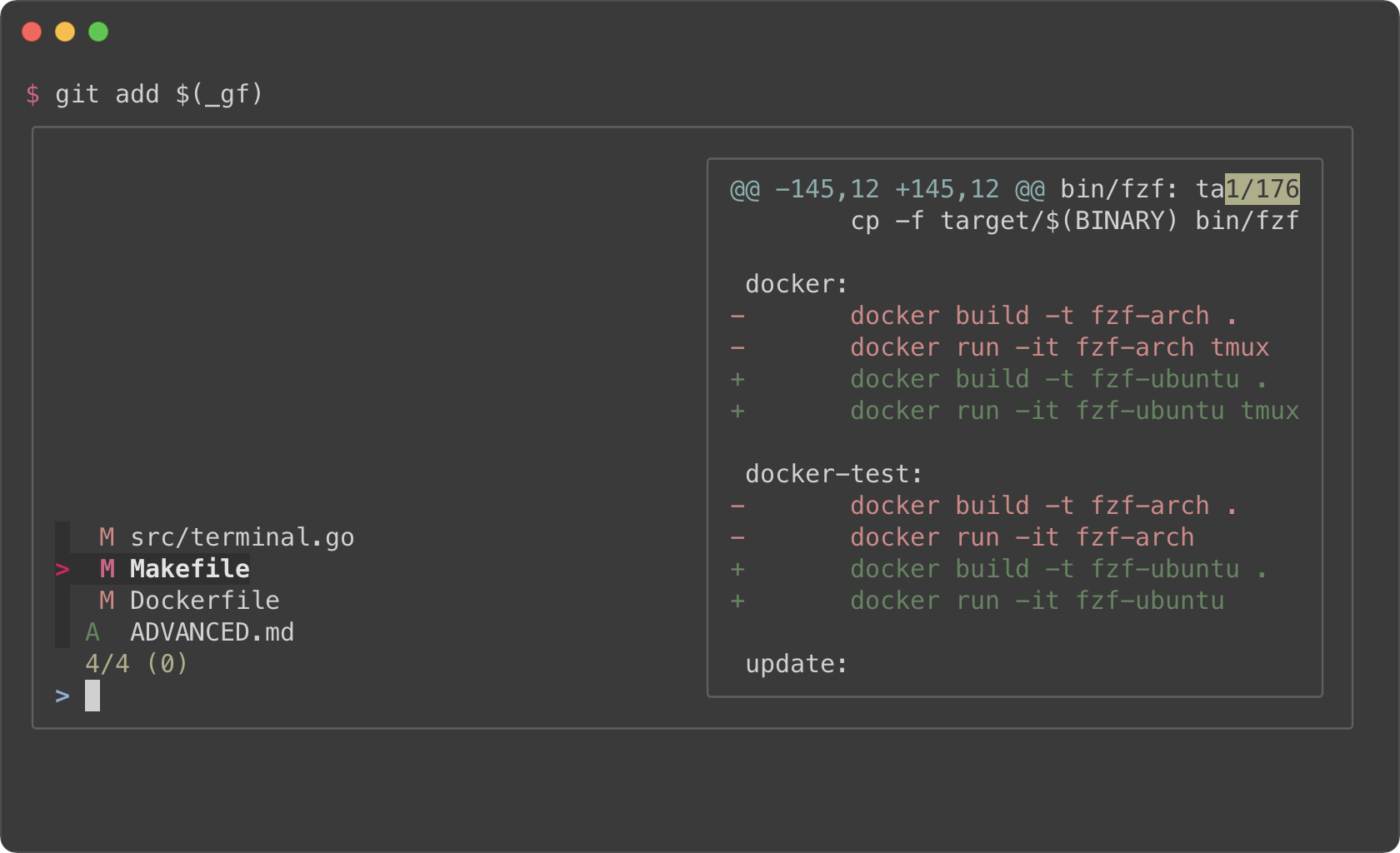
|
||
|
||
### Branches
|
||
|
||
<kbd>CTRL-G</kbd><kbd>CTRL-B</kbd>
|
||
|
||
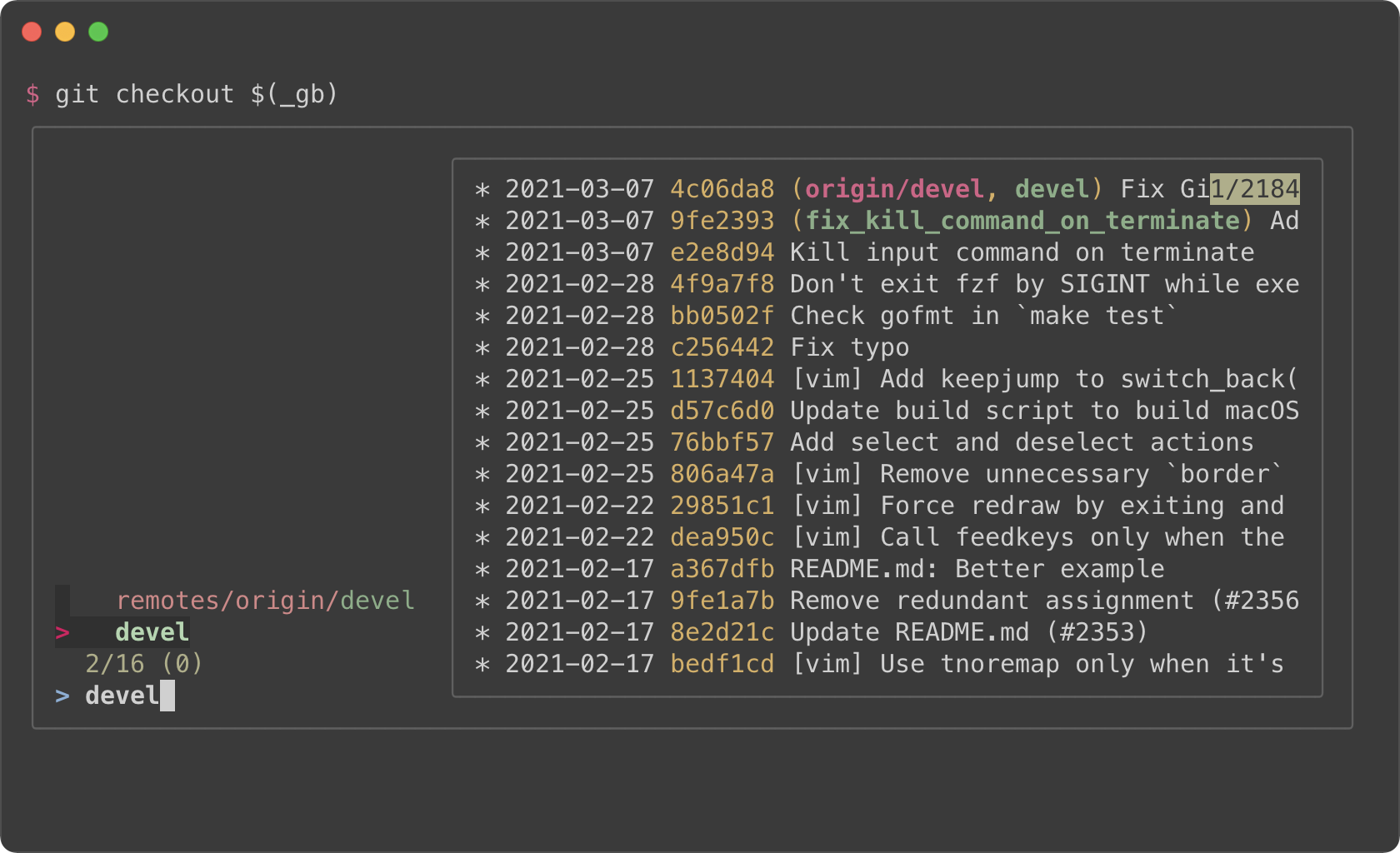
|
||
|
||
### Commit hashes
|
||
|
||
<kbd>CTRL-G</kbd><kbd>CTRL-H</kbd>
|
||
|
||
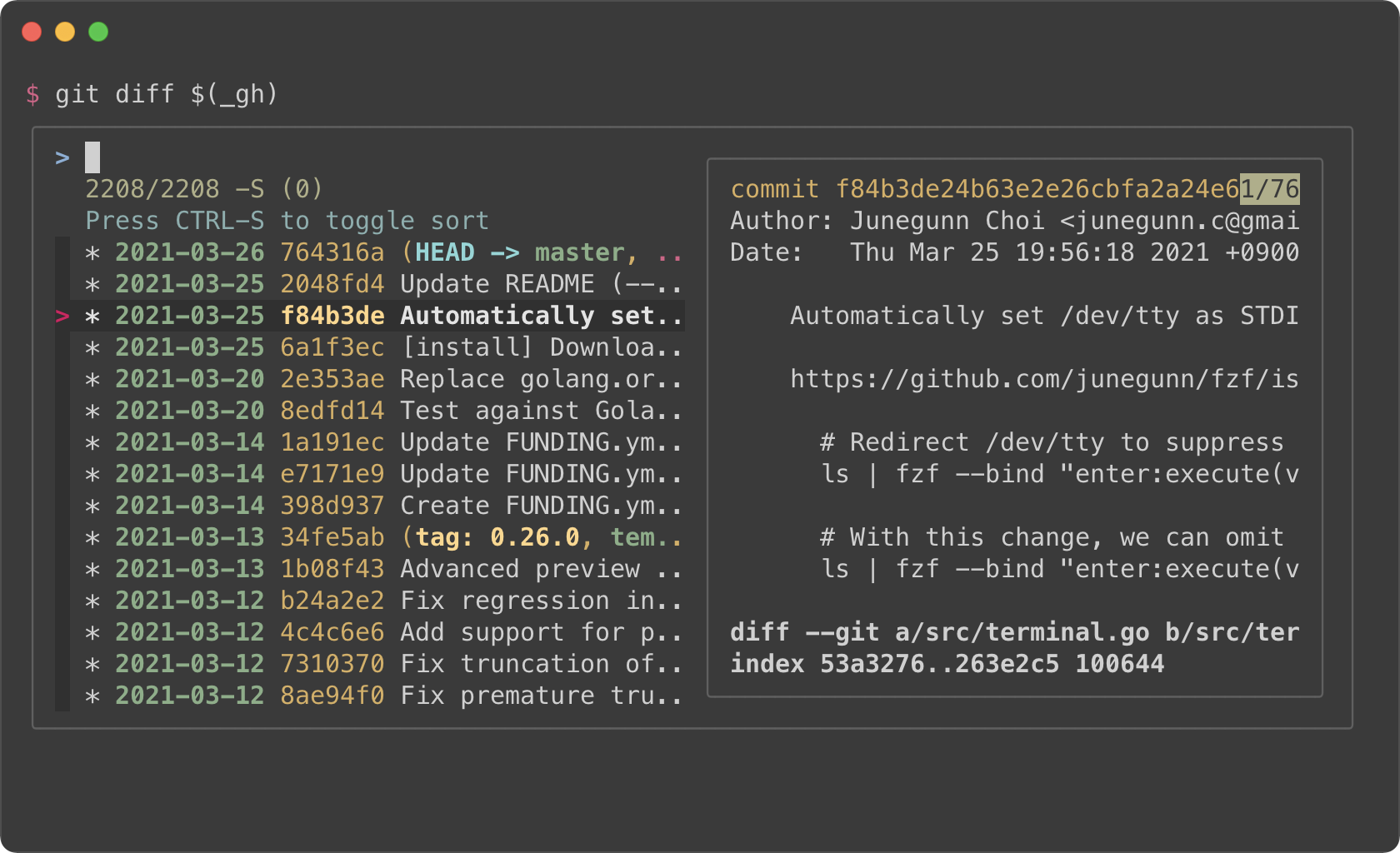
|
||
|
||
Color themes
|
||
------------
|
||
|
||
You can customize how fzf colors the text elements with `--color` option. Here
|
||
are a few color themes. Note that you need a terminal emulator that can
|
||
display 24-bit colors.
|
||
|
||
```sh
|
||
# junegunn/seoul256.vim (dark)
|
||
export FZF_DEFAULT_OPTS='--color=bg+:#3F3F3F,bg:#4B4B4B,border:#6B6B6B,spinner:#98BC99,hl:#719872,fg:#D9D9D9,header:#719872,info:#BDBB72,pointer:#E12672,marker:#E17899,fg+:#D9D9D9,preview-bg:#3F3F3F,prompt:#98BEDE,hl+:#98BC99'
|
||
```
|
||
|
||
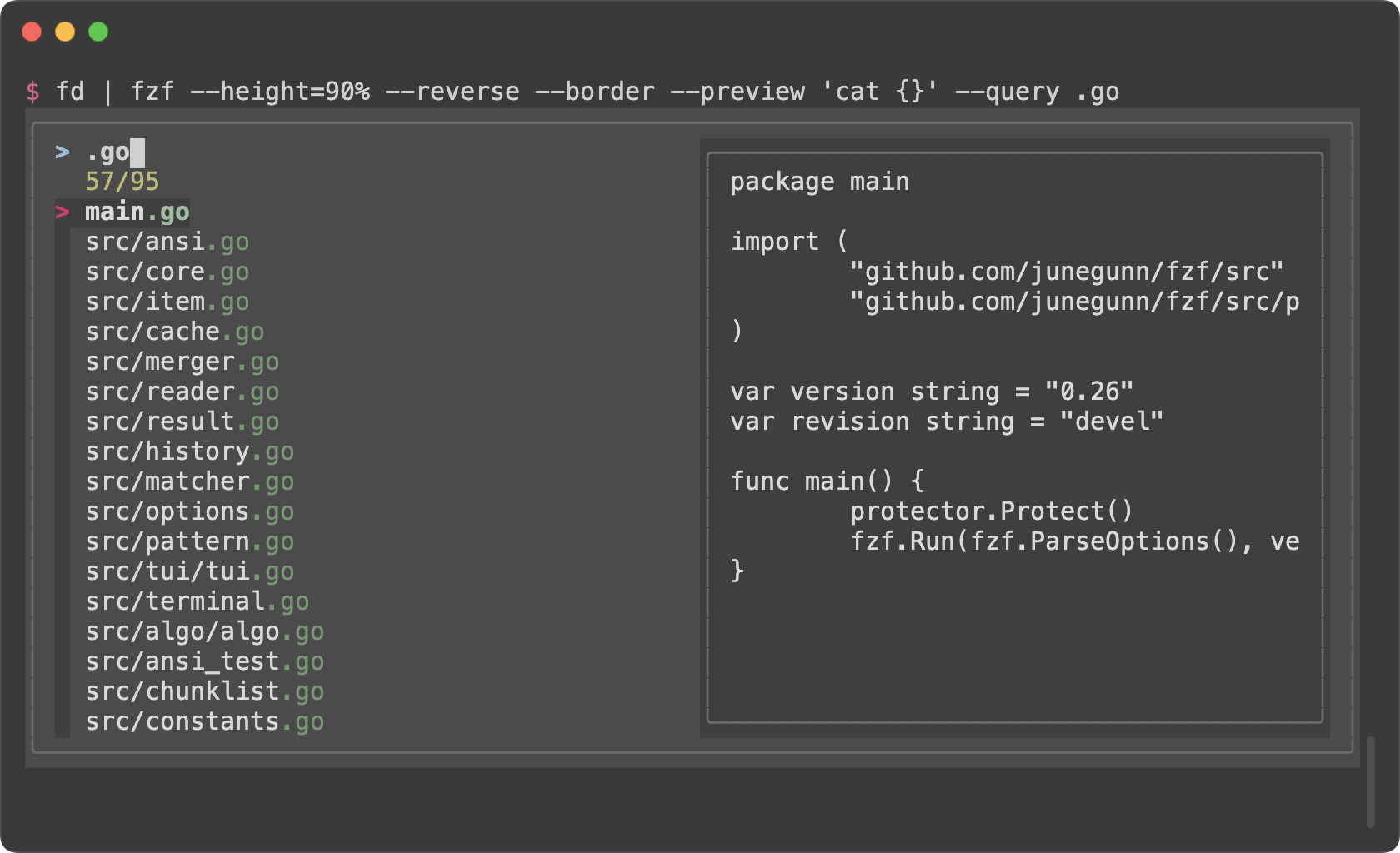
|
||
|
||
```sh
|
||
# junegunn/seoul256.vim (light)
|
||
export FZF_DEFAULT_OPTS='--color=bg+:#D9D9D9,bg:#E1E1E1,border:#C8C8C8,spinner:#719899,hl:#719872,fg:#616161,header:#719872,info:#727100,pointer:#E12672,marker:#E17899,fg+:#616161,preview-bg:#D9D9D9,prompt:#0099BD,hl+:#719899'
|
||
```
|
||
|
||
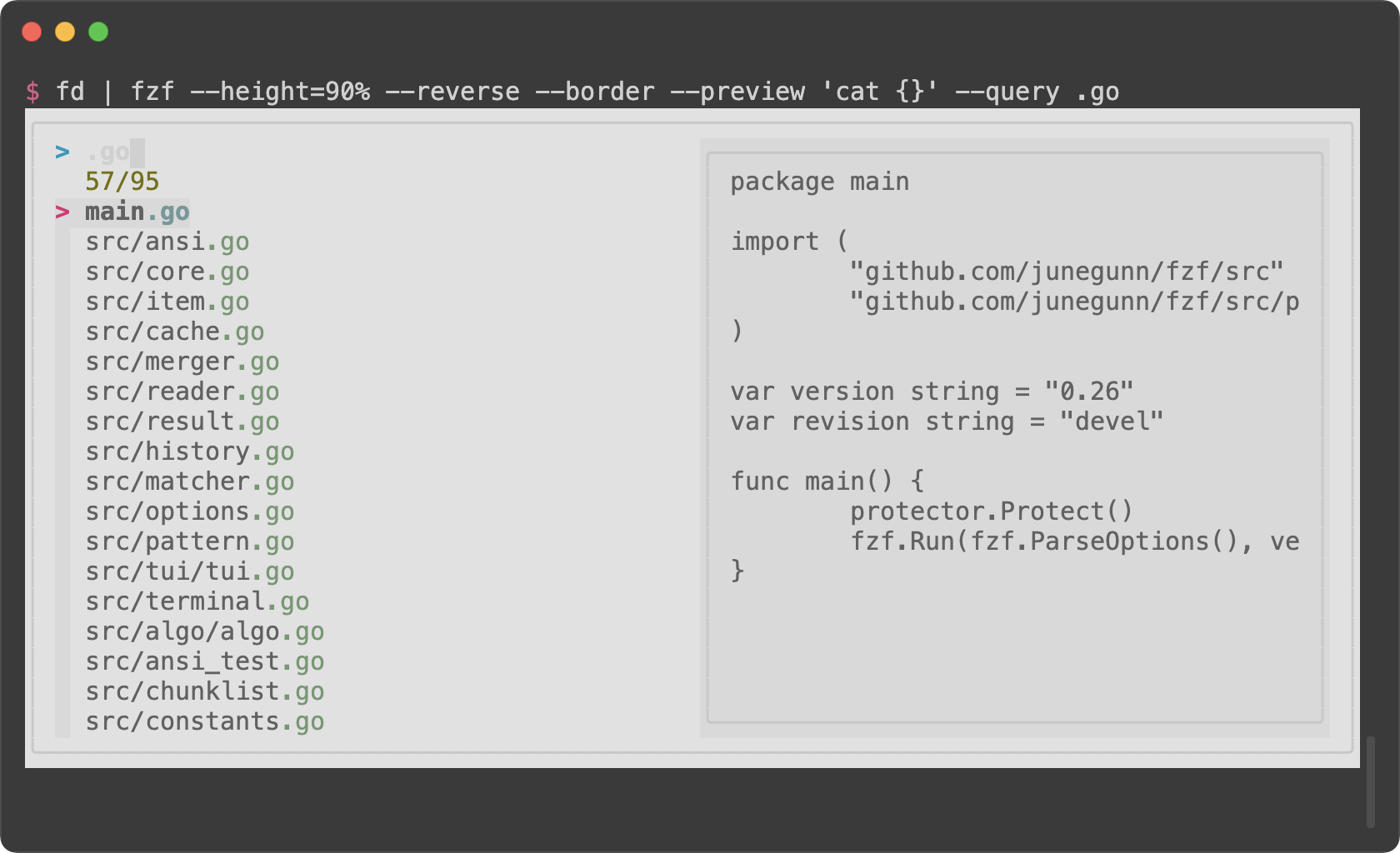
|
||
|
||
```sh
|
||
# morhetz/gruvbox
|
||
export FZF_DEFAULT_OPTS='--color=bg+:#3c3836,bg:#32302f,spinner:#fb4934,hl:#928374,fg:#ebdbb2,header:#928374,info:#8ec07c,pointer:#fb4934,marker:#fb4934,fg+:#ebdbb2,prompt:#fb4934,hl+:#fb4934'
|
||
```
|
||
|
||
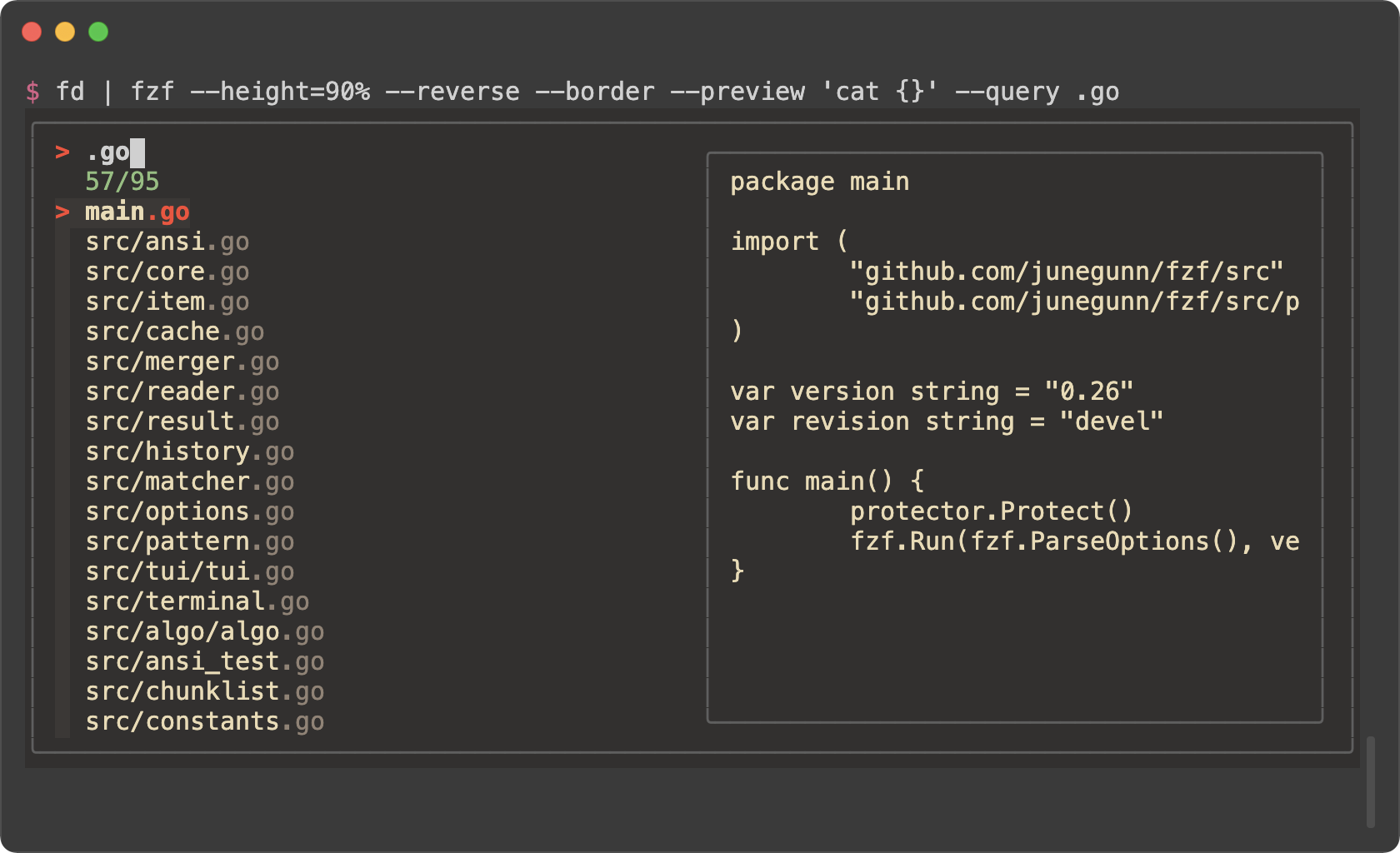
|
||
|
||
```sh
|
||
# arcticicestudio/nord-vim
|
||
export FZF_DEFAULT_OPTS='--color=bg+:#3B4252,bg:#2E3440,spinner:#81A1C1,hl:#616E88,fg:#D8DEE9,header:#616E88,info:#81A1C1,pointer:#81A1C1,marker:#81A1C1,fg+:#D8DEE9,prompt:#81A1C1,hl+:#81A1C1'
|
||
```
|
||
|
||
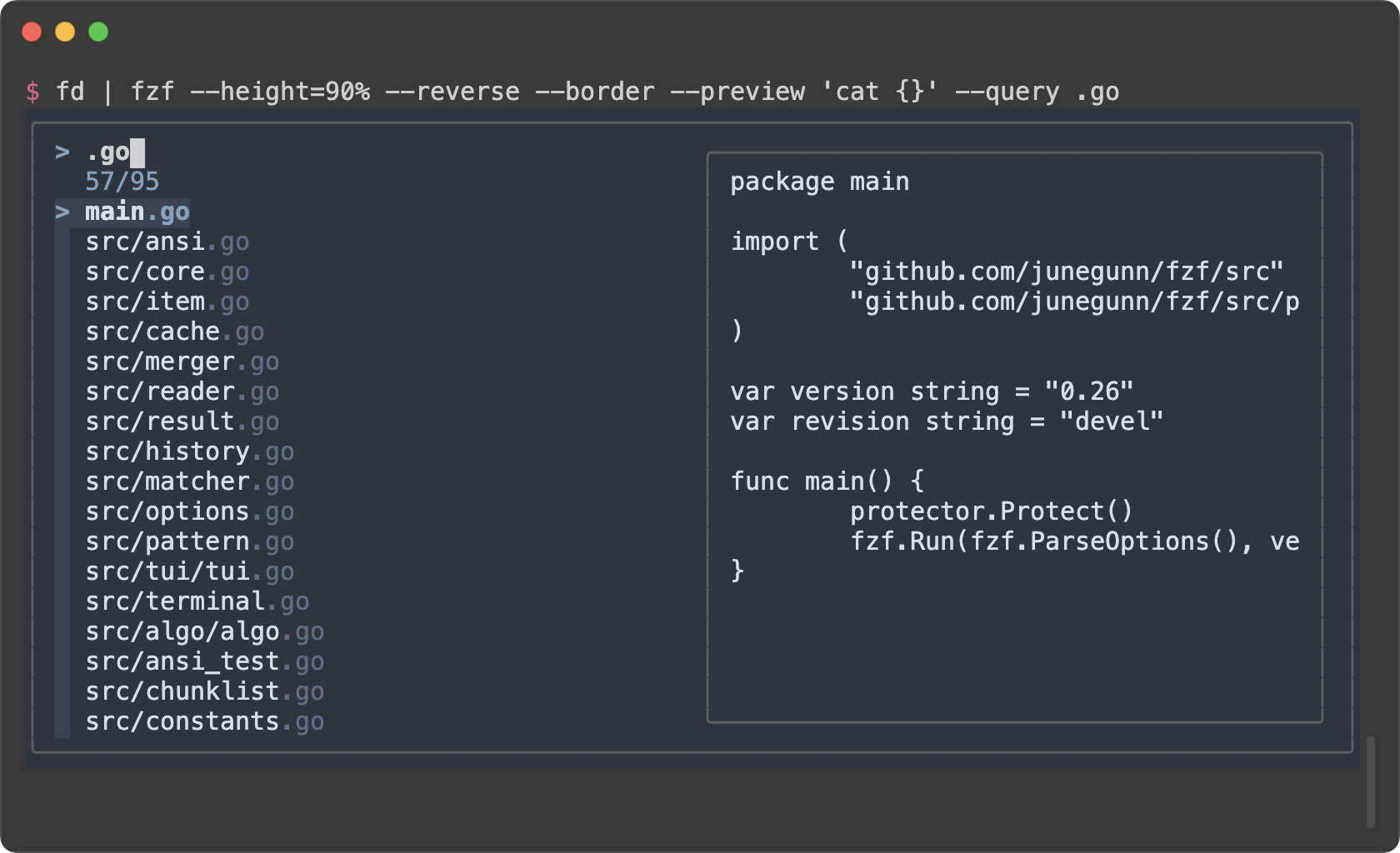
|
||
|
||
```sh
|
||
# tomasr/molokai
|
||
export FZF_DEFAULT_OPTS='--color=bg+:#293739,bg:#1B1D1E,border:#808080,spinner:#E6DB74,hl:#7E8E91,fg:#F8F8F2,header:#7E8E91,info:#A6E22E,pointer:#A6E22E,marker:#F92672,fg+:#F8F8F2,prompt:#F92672,hl+:#F92672'
|
||
```
|
||
|
||
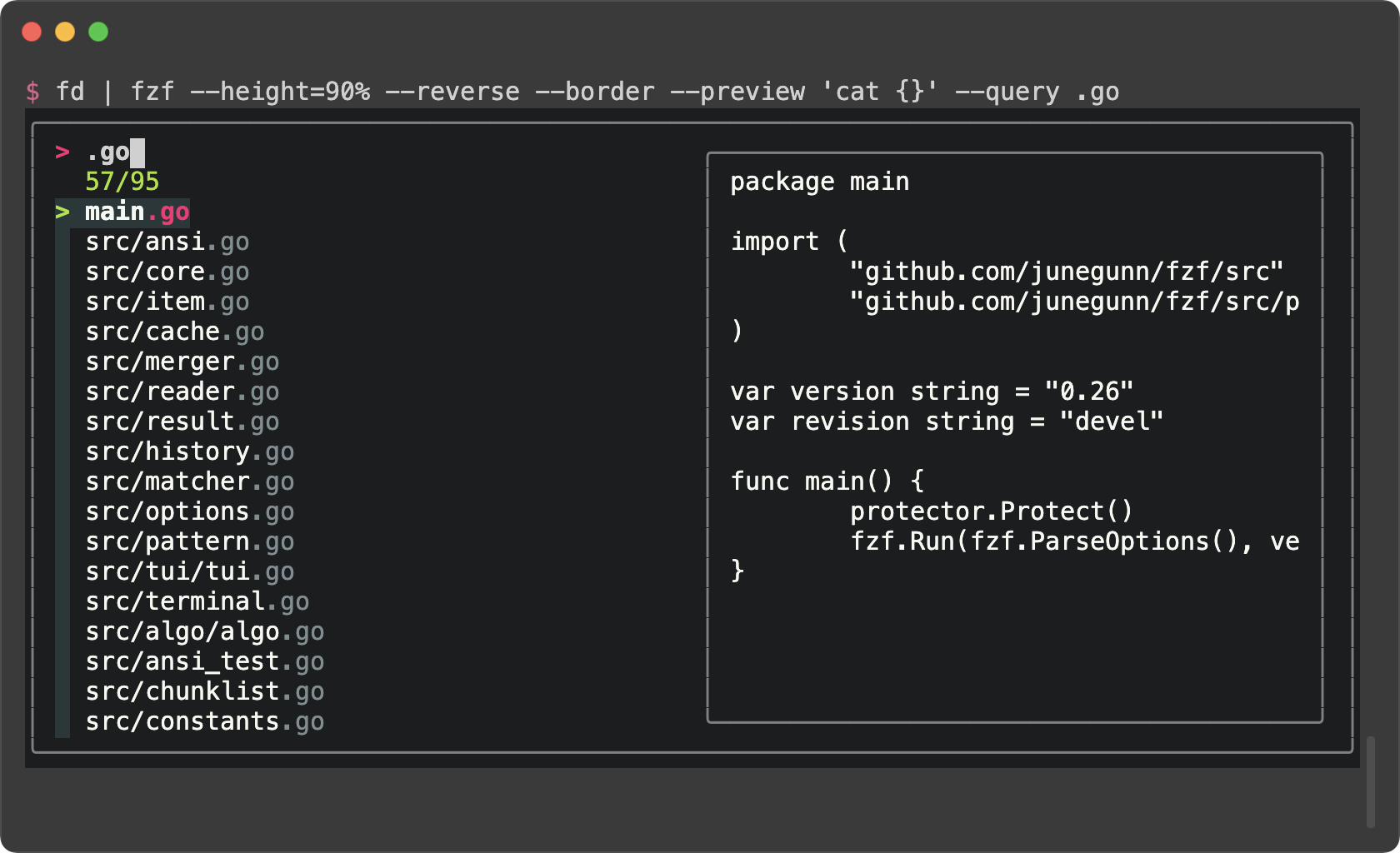
|
||
|
||
### fzf Theme Playground
|
||
|
||
[fzf Theme Playground](https://vitormv.github.io/fzf-themes/) created by
|
||
[Vitor Mello](https://github.com/vitormv) is a webpage where you can
|
||
interactively create fzf themes.
|
||
|
||
### Generating fzf color theme from Vim color schemes
|
||
|
||
The Vim plugin of fzf can generate `--color` option from the current color
|
||
scheme according to `g:fzf_colors` variable. You can find the detailed
|
||
explanation [here](https://github.com/junegunn/fzf/blob/master/README-VIM.md#explanation-of-gfzf_colors).
|
||
|
||
Here is an example. Add this to your Vim configuration file.
|
||
|
||
```vim
|
||
let g:fzf_colors =
|
||
\ { 'fg': ['fg', 'Normal'],
|
||
\ 'bg': ['bg', 'Normal'],
|
||
\ 'preview-bg': ['bg', 'NormalFloat'],
|
||
\ 'hl': ['fg', 'Comment'],
|
||
\ 'fg+': ['fg', 'CursorLine', 'CursorColumn', 'Normal'],
|
||
\ 'bg+': ['bg', 'CursorLine', 'CursorColumn'],
|
||
\ 'hl+': ['fg', 'Statement'],
|
||
\ 'info': ['fg', 'PreProc'],
|
||
\ 'border': ['fg', 'Ignore'],
|
||
\ 'prompt': ['fg', 'Conditional'],
|
||
\ 'pointer': ['fg', 'Exception'],
|
||
\ 'marker': ['fg', 'Keyword'],
|
||
\ 'spinner': ['fg', 'Label'],
|
||
\ 'header': ['fg', 'Comment'] }
|
||
```
|
||
|
||
Then you can see how the `--color` option is generated by printing the result
|
||
of `fzf#wrap()`.
|
||
|
||
```vim
|
||
:echo fzf#wrap()
|
||
```
|
||
|
||
Use this command to append `export FZF_DEFAULT_OPTS="..."` line to the end of
|
||
the current file.
|
||
|
||
```vim
|
||
:call append('$', printf('export FZF_DEFAULT_OPTS="%s"', matchstr(fzf#wrap().options, "--color[^']*")))
|
||
```
|